Lawsuit: Dr. Iman Sadeghi v. Pinscreen Inc., et al. [2018 – Present]

Koki Nagano, Iman Sadeghi, Jila, Hao Li, Ronald Yu & Yen-Chun Chen
| Initial scheduled date for the Jury Trial which was postponded to May 24, 2021 due to ongoing settlement discussions, COVID-19, and other reasons. |
|
|
| Full day mediation and settlement meeting conducted by Retired Judge Hon. Edward A. Ferns between the parties at a confidential location. |
|
|
| Pinscreen's Verified Answer to Sadeghi's Third Amended Complaint (TAC). |
|
|
|
The individual defendats, Hao Li, his wife Yen-Chun Chen, Liwen Hu, and Han-Wei Kung
filed two ex-parte motions in hopes of
some
favorable rulings for the defendants.
The Court denied both of defendants' improper ex-parte motions. |
|
|
|
|
Court hearing on Defendants' Demurrer to the TAC and Sadeghi's Opposition to Defendants' Demurrer to the TAC was held at Stanley Mosk Courthouse. In its final ruling, the Court upheld Sadeghi's causes of action for (3rd CoA) Pinscreen's Retaliation Against Sadeghi's Whistleblowing, (4th CoA) Pinscreen's Breach of Sadeghi's Employment Contract, and (5th CoA) Pinscreen's Wrongful Termination of Sadeghi Against California Public Policy and ordered Defendants to file their verified answer to the TAC within 30 days. See [Court's Ruling for 3rd to 5th CoA] and [Court's Full Ruling]. |
|
|
|
Sadeghi's Opposition to Defendants' Demurrer to the TAC. |
|
|
|
Court hearing for Sadeghi's Motion to Compel Li and Pinscreen to Respond to Discovery. |
|
|
|
Court hearing for Sadeghi's Informal Discovery Conference (IDC). |
|
|
|
Court hearing for the Case Management Conference (CMC). |
|
|
|
Court hearing for Li's Demurrer to the SAC. |
|
|
|
Court hearing for Pinscreen's Demurrer to the SAC. |
|
|
|
Court hearing for the Case Management Conference (CMC). |
|
|
|
Li and Pinscreen filed a Demurrer to the Second Amended Complaint (SAC). |
|
|
Second Amended Complaint: Dr. Iman Sadeghi v. Pinscreen Inc., et al. (SAC)
Happy National Honesty Day! Excerpt from the Second Amended Complaint (SAC) fresh out of the legal oven: "After joining Pinscreen under false pretenses, Sadeghi gradually discovered Li’s grotesque scientific and professional misconduct. Among his various transgressions, Li perpetrated a scientific hoax by proclaiming Pinscreen’s avatars to be autogenerated using cutting-edge deep neural networks and artificial intelligence. In reality, the avatars were being manually prepared and tweaked by Pinscreen employees and freelance artists." |
|
|
|
Li's Lies: Pinscreen's Fake 'Victory' News!
Li took an opportunity to deceive the public—once again—by spreading fake news of Pinscreen’s alleged lawsuit victory. Li’s wife, Yen-Chun Chen, who is the CFO of Pinscreen and also a defendant on the lawsuit, shared Li’s lies and added a few Lies of her own. Jaewoo Seo from Pinscreen also helped with spreading the fake news. Li’s ever shrinking fan base rejoiced and offered their heartfelt congratulations. One skeptical commenter, a UK based Professor in Computer Science, suggested Li to change his lawyers (including Benjamin Davidson), as soon as possible. Read more in Li's Lies: Pinscreen's Fake 'Victory' News! |
|
|
|
Li's and Pinscreen's Demurrers to Sadeghi's
First Amended Complaint (FAC)
Li and Pinscreen filed demurrers to the FAC alleging that it "fails to state facts sufficient to constitute a cause of action." Parties submitted a total of around 138 pages in opposition (~61 pages) and in support (~77 pages) of the demurrers and motion-to-strike against the FAC. The Court did not address defendants' demurrers nor their motions-to-strike and instead ordered Sadeghi to shorten the pleading, remove the evidentiary material, and make it more concise and to file the Second Amended Complaint (SAC) within 20 days. Li and Pinscreen repeatedly injected false claims and contrary facts not on the face of the FAC—in violation of the standard of review—decreasing the efficiency of the judicial process. See Sadeghi's SurReply for a list of 21 sets of provably false statements alleged by Benjamin Davidson on behalf of Li and Pinscreen in their reply briefs. [ Sadeghi's Opposition to Li's Demurrer – Li's Reply ] [ Sadeghi's Opposition to Pinscreen's Demurrer – Pinscreen's Reply ] [ Sadeghi's SurReply ] See the Court's Tentative Ruling. |
|
|
|
Sadeghi's Motion to Compel Li to Respond to Discovery and for Sanctions
The first court hearing for the lawsuit was held today in downtown Los Angeles at the Stanley Mosk Courthouse in which the Judge, Honorable Lia Martin, ruled in Sadeghi's favor and awarded monetary sanctions against Li and his attorney Benjamin Davidson for obstructing discovery. Benjamin Davidson's last request to the Court was that only Li would be sanctioned and not himself. The Judge declined the defense attorney's plea and sanctioned both. See the Court's Tentative Ruling and Minute Order. |
|
|
| Li's first round of admissions under penalty of perjury where Li authenticates the footage of the Battery. |
|
|
|
Li's Lies: Pinscreen's Assault and Battery on Sadeghi
The security camera footage of the physical altercation incident was obtained through a subpoena of the building security. The footage confirms Sadeghi’s Allegations and exposes Li’s Lies. |
|
|
| Sadeghi filed a Motion to Compel Li to Respond to Discovery and for Sanctions against Li and his attorney Benjamin Davidson. |
|
|
| Li and Pinscreen filed a Demurrer and a Motion-to-Strike to the First Amended Complaint (FAC). |
|
|
|
USC v. Dr. Hao Li Truth Challenge
I appeal to all individuals who value #science, #integrity, and the #truth to invite USC to challenge Li to explain the context for his use of the word “cheating,” which he used to characterize Pinscreen’s conduct and to invite Li to accept the challenge. #truthchallenge |
|
|
|
Li responded through USC Annenberg Media that he doesn't refute the existence of the screenshotted messages,
but said in a recent email to Annenberg Media that they are easy to misinterpret.
Li also stated that “the messages and screenshots are presented in a manner that allows them to be taken out of context quite easily.” |
|
|
|
Scientific Integrity v. Pinscreen Truth Challenge
I appeal to my coauthors, collaborators, and colleagues; my fellow scientists, academics, researchers, and engineers; Computer Science, Computer Graphics, and SIGGRAPH communities; ACM, ETH Zürich, USC, USC ICT, and USC Viterbi School of Engineering; friends, family, and individuals who value #science, #integrity, and the #truth to demand and challenge Pinscreen and its affiliates to identify any communication or item of evidence within the verified amended complaint that they allege to be “fabricated.” #truthchallenge |
|
|
|
Verified First Amended Complaint: Dr. Iman Sadeghi v. Pinscreen Inc., et al. (FAC)
Sadeghi filed the verified amended complaint with additional conclusive evidence for Pinscreen's and Li's data fabrication, acaemic misconduct, and other unlawful practices. |
|
|
| Li and Pinscreen filed for Extension of Time with the Superior Court of California. [view] |
|
|
| Li and Pinscreen filed for Extension of Time with the Superior Court of California. [view] |
|
|
| Li responded on Facebook and LinkedIn and alleged "[…] that individual has taken aggressive actions to defame us publicly with false accusations, and has fabricated communications and other evidences [sic] to portray us negatively to our peers […] " [view] |
|
|
| "I dare Dr. Hao Li to accept my Truth Challenge," Sadeghi told The Register. |
|
|
|
Dr. Iman Sadeghi v. Dr. Hao Li Truth Challenge
I challenge Li on Facebook , Twitter , LinkedIn , Google+ , and Instagram to confirm his position on a small subset of community relevant allegations, under penalty of perjury, by signing the challenge form and sharing it publicly on his social media. I appeal to my coauthors, collaborators, and colleagues; my fellow scientists, academics, researchers, and engineers; Computer Science, Computer Graphics, ACM and SIGGRAPH communities; friends, family, and individuals who value #science, #integrity, and the #truth to invite Li to accept the challenge. #truthchallenge |
|
|
|
Li responded in the Los Angeles Times and alleged that "all the allegations are 100% false." |
|
|
|
Verified Complaint: Dr. Iman Sadeghi v. Pinscreen Inc., et al.
I, Dr. Iman Sadeghi, filed a verified complaint in the Superior Court of California against Pinscreen Inc., et al. I allege that Pinscreen and its CEO, Dr. Hao Li, perpetrated Fraud and Deceit, Data Fabrication, and Academic Misconduct supported by conclusive evidence. |
|
This is an action for employment fraud and numerous consequent illegal acts. Plaintiff Iman Sadeghi, who holds a doctorate in Computer Science/Computer Graphics, developed and patented a novel hair-appearance technology used at Walt Disney Animation Studios. After having worked at Google as a software engineer for more than five years, Sadeghi was solicited by defendant Hao Li to join the leadership of a software start-up, Pinscreen Inc., which Li cofounded. Pinscreen specializes in automatically generating animated 3D face models, called avatars, from only a photograph of a person. Hao Li, Pinscreen’s CEO, is an assistant professor at the University of Southern California. Dr. Sadeghi alleges—supporting these allegations with documentary proof in a verified complaint—that Dr. Li lied to and defrauded him when Li obtained Sadeghi's employment as Pinscreen’s Vice President of Engineering. Li fraudulently induced Sadeghi to resign from Google and join Pinscreen by intentionally misrepresenting Pinscreen’s technology as Li deceived the public, the scientific community, and its investors.
After being deceived into joining Pinscreen, Sadeghi gradually discovered Li’s grotesque academic and professional misconduct. Among his various transgressions, Li perpetrated a scientific hoax by proclaiming Pinscreen’s avatars as automatically generated using “cutting-edge” deep neural networks and artificial intelligence. In reality, the avatars were being manually prepared and tweaked by Pinscreen employees and freelance artists.
In retaliation for Sadeghi’s whistleblowing and objections to Li’s data fabrication, academic misconduct, fraud on investors, labor law violations, and immigration law violations, Pinscreen illegally terminated Sadeghi within his first working hour after Pinscreen deceived an audience of thousands.
Sadeghi’s significant contributions to Pinscreen are well documented and his personnel file is bereft of any concerns whatsoever regarding his performance or employment. Li boasted about having Sadeghi onboard at Pinscreen, celebrating him as “the best” in digital hair appearance which is a stark contrast to Li now maligning Sadeghi as “an abject failure.”
The consequent torts committed by Li include a brutal battery of Sadeghi, where Li and a group of employees, under Li’s commands, physically attacked Sadeghi and invaded his belongings. Even though the security cameras captured the brutal attack, Li denied the allegations in the press stating “all the allegations are 100% false,” “no one assaulted [Sadeghi],” and went so far as to allege that “the exact opposite happened.” The now public security camera footage of the security camera footage of the battery confirms Sadeghi’s allegations and exposes Li’s lies.
The ruthless character required to perpetrate a fraud on the core values of one’s profession combined with the stakes for Li may help the Court understand Li’s approach to this litigation: deny everything, concede nothing. Whereas this case directly concerns Li’s fraud on Sadeghi, it is most germane that Li’s fraud on Sadeghi was in furtherance of the fraudulent product offered by Li’s company. To fully understand Li’s motives, the Court will need to consider the significance of the broader fraud as it bears on Li, a rising assistant professor. When levelled against an academician and scientist, the allegations against Li are grave. The strongest community strictures prohibit scientists from submitting fabricated data; in so doing—violating core ethical commitments of his profession—Li incurred the most serious professional risks.
1. Sadeghi holds a doctorate in Computer Science/Computer Graphics from the University of California, San Diego (“UCSD”). He developed, published, and patented a novel digital hair appearance framework for Walt Disney Animation Studios’ movie Tangled and has presented his work in prestigious scientific forums. After having worked at Google as a Software Engineer for more than five years, Sadeghi was solicited by Pinscreen to join the company’s leadership.
2. Pinscreen is a software start-up specializing in automatically generating animated 3D face models, called avatars, using only a photograph of a person. Li, an assistant professor at University of Southern California (“USC”), is one of the co-founders and the Chief Executive Officer (“CEO”) of Pinscreen.
3. Defrauding Sadeghi, Pinscreen, through Li, knowingly misrepresented Pinscreen’s avatar generation capabilities to Sadeghi and concealed its various illegal practices from him. Pinscreen’s and Li’s unlawful conduct involved a variety of fraudulent activities including misrepresenting manually prepared avatars as automatic, which is at the heart of Pinscreen’s technical claims.
4. In reliance on Li’s fraudulent misrepresentations to him, Sadeghi resigned from Google and joined Pinscreen as its VP of Engineering. While working to improve the quality of Pinscreen’s infrastructure and avatars, Sadeghi gradually discovered Li’s and Pinscreen’s various illegal practices, including deliberately misreporting purportedly scientific experiments or their results (data fabrication), academic misconduct, fraud on investors, labor law violations, and immigration law violations.
5. When confronted by Sadeghi regarding the data fabrication and academic misconduct, Li asserted that Pinscreen would achieve its inflated claims in time for subsequent publications, which Li considered to be crucial for Pinscreen’s industry exposure and success. Li promised Sadeghi that Pinscreen would never fabricate its results in public representations.
6. Li broke this promise on August 1, 2017, when Pinscreen and Li publicly mispresented fabricated avatars on the stage of ACM’s SIGGRAPH 2017 Real-Time Live (“RTL”) to an audience of thousands.
7. In retaliation for Sadeghi’s objections and whistleblowing regarding Li’s data fabrication, academic misconduct, fraud on investors, labor law violations, immigration law violations, and other unlawful practices, Pinscreen illegally terminated Sadeghi, on August 7, 2017, within Sadeghi’s first working hour after Pinscreen’s fabricated demo at RTL.
8. On the day of the wrongful termination, various defendants committed multiple other torts against Sadeghi, including assault and battery and invasion of privacy. As a result of the battery, Sadeghi has suffered severe physical, mental, and emotional distress as well as physical injuries requiring medical attention, physical therapy, and psychotherapy.
9. Following the wrongful termination, Pinscreen committed additional breaches of contract and engaged in other unlawful conduct, such as withholding business expense reimbursements, withholding the check for penalties for late wage payments, and damaging Sadeghi’s personal property.
10. Sadeghi brings this action to vindicate his legal rights, and more importantly, to benefit the public; to preserve the integrity of scientific research; to safeguard Computer Science, Computer Graphics, ACM and SIGGRAPH communities; and to protect Pinscreen’s employees and investors, while preventing Li, Pinscreen, and other defendants from engaging in further unlawful practices.
23. Sadeghi earned his B.Sc. degree in Computer Engineering in 2006 and graduated first in class from Sharif University of Technology. Shortly after, Sadeghi started graduate school at the University of California, San Diego (“UCSD”) in the field of Computer Science.

24. In 2007, Sadeghi was awarded the Grand Prize in UCSD’s Rendering Competition. Rendering is the process of automatically generating the appearance of digital objects using computers. In 2008, Sadeghi collaborated with Walt Disney Animation Studios (“Disney”) on hair rendering (i.e. digital hair appearance) and received his M.Sc. degree in Computer Science/Computer Graphics on the topic. (Exhibits A1, A2)

25. Sadeghi worked at Disney during 2008 and 2009 and developed a novel hair rendering framework for the production of the movie Tangled. In 2010, Sadeghi presented the framework at the Association for Computing Machinery’s SIGGRAPH conference. The Association for Computing Machinery (“ACM”), is the world’s largest scientific and computing society and the organizer of annual conference SIGGRAPH, widely recognized by experts as the most reputable conference in the field of Computer Graphics. Sadeghi is also a co-inventor of the patent on the framework filed by Disney. The following figure features some of the results of the hair rendering framework: (Exhibits A2, A3, A4)

26. Li later introduced Sadeghi as “the guy behind all the hair rendering tech for Disney and DreamWorks” and, on information and belief, referred to Sadeghi as “the best hair rendering guy.” (Exhibits A5, A6)
[ Show Hidden Text ⇓ ]27. [April 18, 2017] Li: “Please meet Iman [Sadeghi], the guy behind all the hair rendering tech for Disney and DreamWorks (incl. Tangled)”
28. [June 1, 2017] Li: “We have the best hair rendering guy”

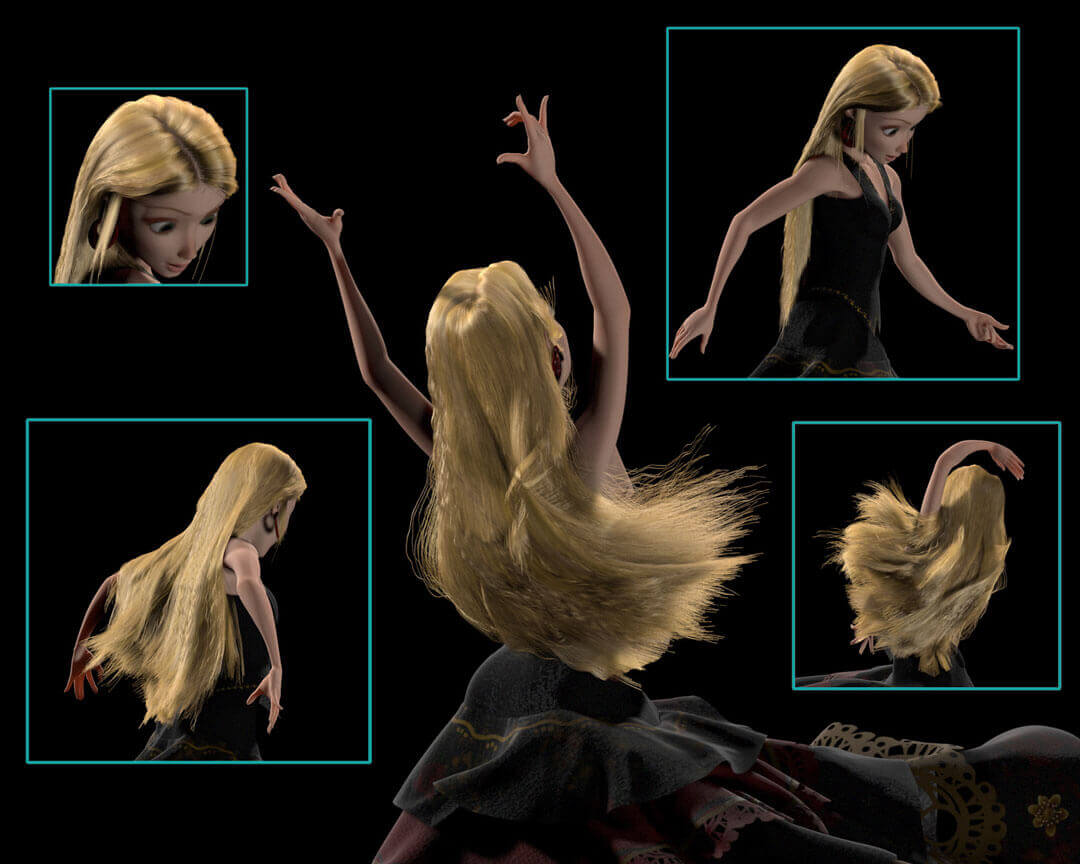
29. In 2010, Sadeghi worked at Industrial Light & Magic (“ILM”) and became acquainted with Li. On information and belief, Li was attending graduate school also in the field of Computer Graphics. During the same year, Li requested that Sadeghi connect with him on Facebook and LinkedIn. Sadeghi and Li stayed in touch over the years and referred to each other as good friends. (Exhibits A7, A8)
30. On June 11, 2011, Sadeghi was ceremonially honored when he received his Ph.D. from UCSD in Computer Science/Computer Graphics. Later, Sadeghi presented his scientific research from his Ph.D. dissertation, in the field of rendering and appearance modeling, at SIGGRAPH 2012 and SIGGRAPH 2013. (Exhibits A9, A10, A11)
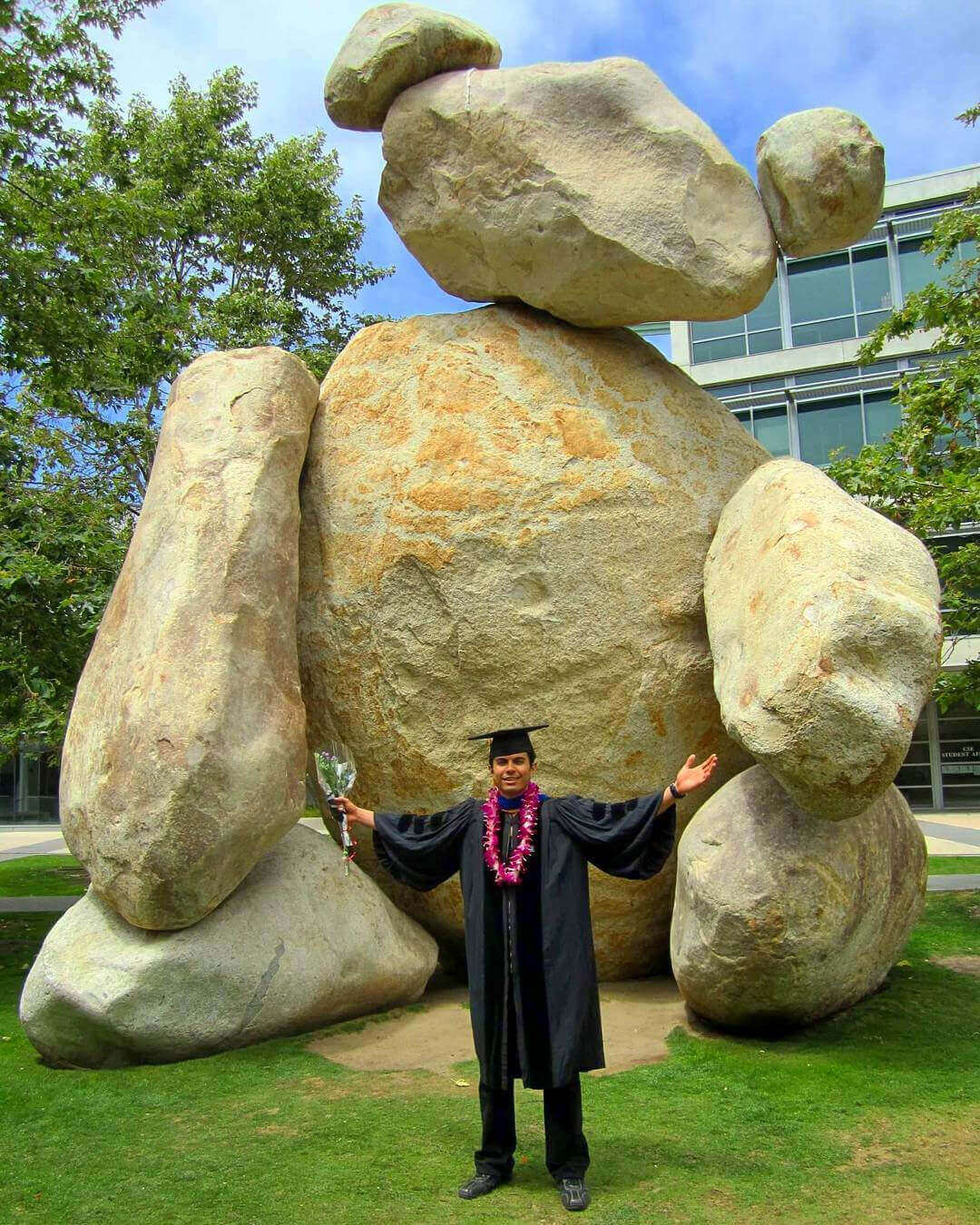

31. Sadeghi joined Google as a Software Engineer on August 15, 2011 and gained experience with Robust Software System Architectures, Reliable Scalable Distributed Systems, and Deep Convolutional Neural Networks. Among other achievements, Sadeghi is also a co-inventor of five patents filed by Google.

32. On information and belief, Li received his M.Sc. from Universität Karlsruhe in 2006, received his Ph.D. from Eidgenössische Technische Hochschule Zürich (“ETH Zurich”) in 2010, became an assistant professor at University of Southern California (“USC”) in 2013, co-founded Pinscreen in 2015, and solicited Sadeghi to join Pinscreen’s leadership in 2016.
33. Li praised Sadeghi and told him, “I do believe that you will bring a lot to the company,” “I think if you join us, you would bring a lot of energy with you,” and that “you bring in exceptional potential, knowledge and leadership.” Li told Sadeghi that he thinks Zuberi “likes you a lot;” Fursund “thinks u [sic] are awesome;” and Kim and Zuberi “really like you and we really want you to join us.” Li also stated that “we have been really impressed by you and are very thrilled with the possibility of having you,” as well as “we love to work with you if there is a chance.” (Exhibits B6, B8, B9, B14, B15, B16)
34. Even on the last day of Sadeghi’s employment at Pinscreen, on August 7, 2017, Li praised Sadeghi and told him:
35. [August 7, 2017] Li: “You bring a lot of positive energy and did a lot of things that brought us so far.”
36. [August 7, 2017] Li: “As a person I really think you bring the most to this company.”
37. [August 7, 2017] Li: “I think you have charisma, you bring a lot of people to work together, you motivate people. People like you as a person.”

38. In early October of 2016, during a scientific conference in Amsterdam, Netherlands, Li, the CEO and co-founder of Pinscreen, and Fursund, the CTO of Pinscreen, approached Sadeghi and invited him to join the company, which Li followed up through Facebook messages, in November of 2016. Pinscreen’s solicitation of Sadeghi included dining with Kim in Seattle, dining with Li in Santa Monica, a remote video conference call with Fursund who was in Denmark, as well as a phone conversation with Zuberi. Li’s continual attempts to persuade Sadeghi to join Pinscreen lasted until late January of 2017. (Exhibits B1, B2, B3, B4, B7, B12, B13, B17)

39. [November 8, 2016] Li: “Join us!”
40. [December 1, 2016] Li: “We all want you to join, we are working out [sic] on a good offer”
41. [December 26, 2016] Li: “However, I think if you join us, you would bring a lot of energy with you”
42. [December 26, 2016] Li: “I think we can increase a bit”
43. [December 26, 2016] Li: “How can I hire you?”
44. [December 26, 2016] Li: “Tell me a number”
45. [December 26, 2016] Li: “But we would love to work with you if there is a chance”
46. [January 19, 2017] Li: “😞”
47. [January 19, 2017] Li: “Please sleep over it”
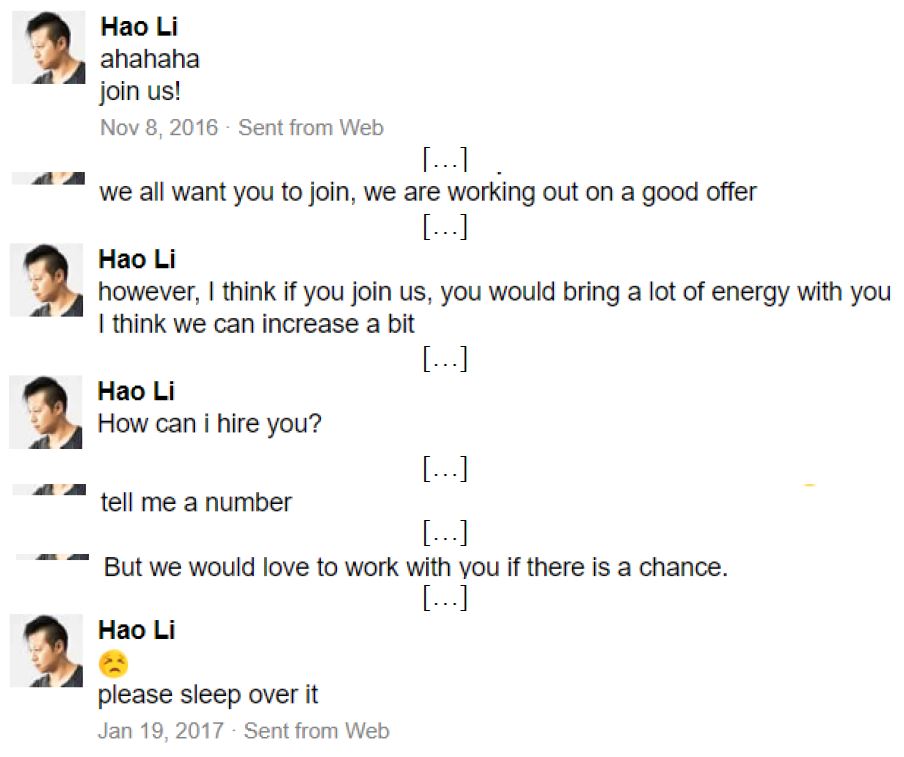
48. Li offered Sadeghi the “leadership role” of “VP of Engineering” and described it as “potentially having a more important role than CTO.” Li told Sadeghi that his responsibilities would be to “make sure other people work,” “coordinate teams and also ensure efficient deliverables,” and to “oversee the technology development of everyone and push it to the next level.” (Exhibits B18, B19)
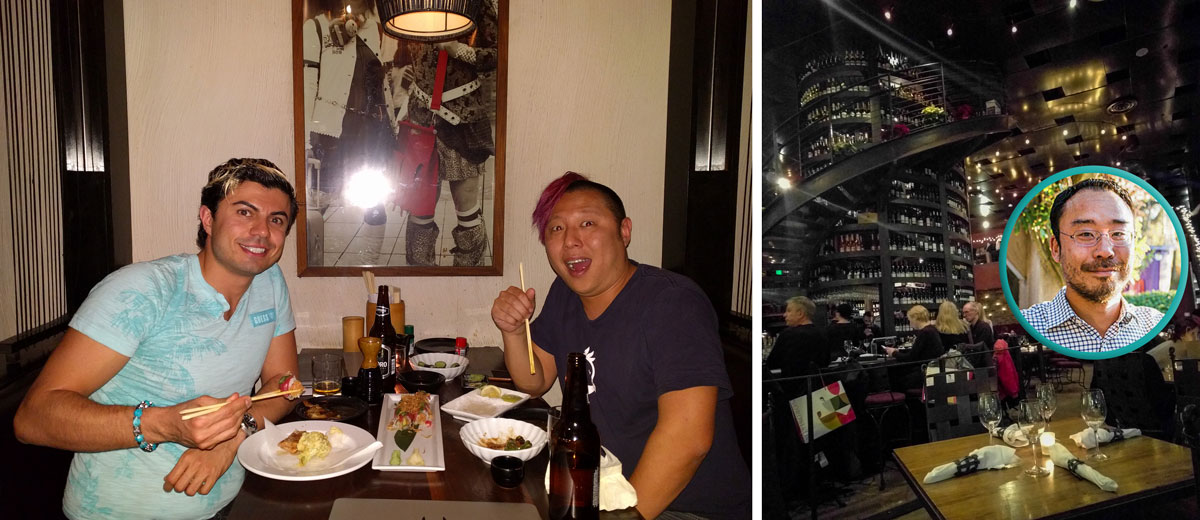
49. In response to Sadeghi’s concern for potential risks, Li stated “I don’t think there are any risks” for Sadeghi in joining Pinscreen, and that “I’m quite sure the reward is bigger than what [sic] the other companies, not only in terms of impact but also financially.” (Exhibits B10, B12)
50. After claiming that “for startup at our stage the biggest benefit is in stock options,” Li offered Sadeghi $165,000 in salary and 2.3% of Pinscreen’s shares. Sadeghi’s employment contract stated that Pinscreen shall provide Sadeghi equity awards equal to 2.3% ownership of Pinscreen over a four-year vesting period, plus additional stock options to “counteract the dilutive effect” of company’s Series A round of financing on Sadeghi. (Exhibits B5, B11, B20, G)
51. [December 26, 2017] Li: “♥️”
52. [December 26, 2017] Li: “I can discuss again with the board, but I would like to offer you for the polar bear heart: 165K + 2.3%”
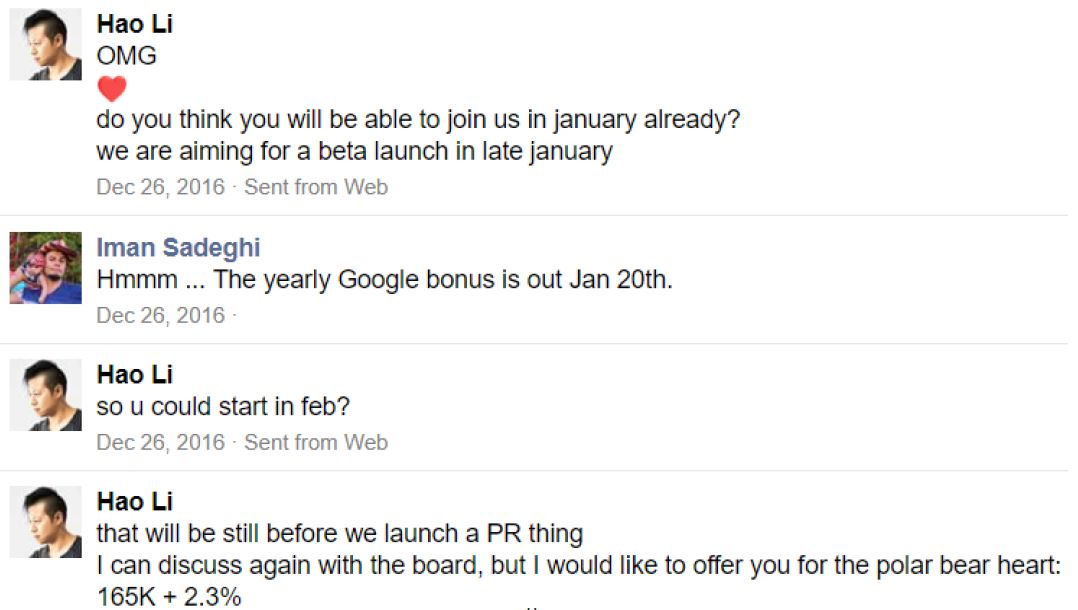
53. Li repeatedly implied long-term plans for Sadeghi’s employment. For instance, on December 18, 2016, Li wrote to Sadeghi, “I believe we can do amazing work together and […] build a successful company together,” “we hope that you join our journey, being part of the first employees,” “as we move to the next rounds of fundings [sic] and growth, the value of the company is likely to increase significantly, so you would be joining at a great time now.” Additionally, on February 18, 2017, Li re-emphasized on the long-term vision for Sadeghi’s employment and wrote that “after four years, he [Sadeghi] will get all of” his stock option shares. (Exhibits B8, B21)
54. Li wrote on November 8, 2016 and December 26, 2016 that Pinscreen’s valuation was $30 million. During a phone conversation on February 21, 2017, Pinscreen’s counsel informed Sadeghi that the company’s valuation was $57.5 million. Li stated on June 17, 2017 that after the investment agreement with Softbank Venture Korea (“Softbank”), Pinscreen's valuation had increased to more than $100 million. (Exhibits B1, B11)
55. Pinscreen is a software start-up specializing in automatically generated animated 3D face models, called avatars, using only an input image. Competitor companies include Loom.ai, ObEN, and FaceUnity.
56. The following diagram demonstrates subprocesses of Pinscreen’s avatar generation technology which are relevant to this complaint. Subprocesses marked with an asterisk ( * ) are among the ones that Pinscreen has misrepresented. The Hair Appearance subprocess, marked with an obelisk ( † ), is within Sadeghi’s expertise and was significantly improved by his contributions:

57. Relevant components of Pinscreen’s technology include the following:
[ Show Hidden Text ⇓ ]58. Input Image: Digital photograph of a person used to generate the output avatar.
59. Hair Shape* or Hair Reconstruction*, Hair Fitting*: The process of automatically estimating the shape of the hair (turquoise area) from the input image. This process has been fabricated by Pinscreen multiple times.
60. Face Shape or Face Reconstruction, Face Fitting: The process of automatically estimating the shape of the face (coral area) from the input image.
61. Hair Color*: The process of automatically estimating the hair color from the input image. This process has been fabricated by Pinscreen.
62. Eye Color*: The process of automatically estimating the eye color from the input image. This process has been fabricated by Pinscreen.
63. Hair Appearance† or Hair Rendering†, Hair Shading†: The process of automatically generating the hair appearance from the estimated hair shape (turquoise area) and hair color. As an expert in hair rendering, Sadeghi significantly improved the quality of Pinscreen’s digital hair appearance.
64. Face Appearance: The process of automatically generating the appearance of the face from the estimated face shape (coral area) and eye color.
65. Relevant terminology to this complaint includes the following:
[ Show Hidden Text ⇓ ]66. Speed of Avatar Generation: The time it takes to generate an avatar in real-time.
67. Pre-Cached or Pre-Built Avatar: Avatar that has been previously generated.
68. Brand-New Avatar: Avatar generated from a brand-new input image, e.g. an image from the webcam, which cannot be pre-cached and has to be generated in real-time.
69.
Fabricated Avatar: Pinscreen’s avatar fabrication included:
• A manually prepared avatar misrepresented as automatic.
• A pre-cached avatar misrepresented as brand-new and/or in real-time.
70. Li deceived Sadeghi by intentionally misrepresenting Pinscreen’s technical capabilities to Sadeghi and intentionally concealing its numerous illegal practices from him.
71. On information and belief, Li persuaded Sadeghi to join Pinscreen in order to gain access to Sadeghi’s expertise and experience in digital hair appearance and software engineering.
72. On January 22, 2017, before Sadeghi had signed the contract to join Pinscreen, Li sent him, through Facebook messages, two examples of purportedly automatically generated avatars. Sadeghi specifically inquired of Li as to whether the hair of the presented avatars had been automatically generated (“autogenerated”), to which Li responded “yes.” (Exhibit C1)
73. [January 22, 2017] Sadeghi: “Autogenerated hair?”
74. [January 22, 2017] Li: “Yes”
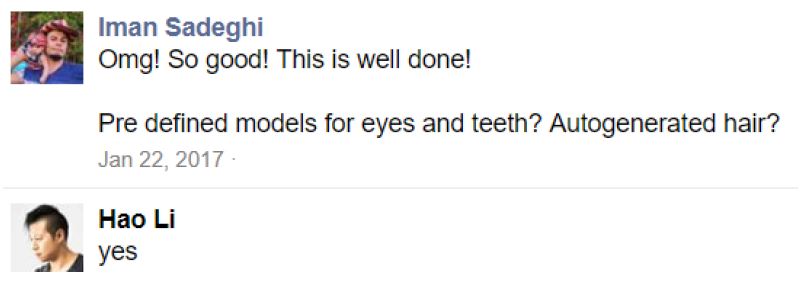
75. Li’s claim that the presented avatars and their hair were automatically generated was a brazen lie. Even up to six months after Li’s initial presentations to Sadeghi, Li and Pinscreen repeatedly fabricated avatars in various representations, including by misrepresenting manually prepared hair shapes as automatically generated.
76. For instance, Pinscreen misrepresented manually prepared hair shapes as automatically generated in its SIGGRAPH RTL submission on April 4, 2017; SIGGRAPH Asia Technical Papers submission on May 23, 2017; SIGGRAPH RTL public demo on August 1, 2017; as well as business representations to investors including, on information and belief, Softbank.
[ Show Hidden Text ⇓ ]77. Prior to Sadeghi’s signing the contract with Pinscreen, Li had further misrepresented Pinscreen’s technical capabilities. For example, on December 26, 2016, Li claimed that Pinscreen has built “a technology that is state of the art,” and on January 19, 2017, that Pinscreen has “high quality hair.” (Exhibits C2, C3)
78. Shortly after Sadeghi joined the company, Li contradicted his prior claims on multiple occasions. For instance, on March 1, 2017, Li evaluated various components of Pinscreen’s technology, including the hair component as “shit” or “complete crap,” and on March 13, 2017, Li stated that, the “avatar hair reconstruction is shit.” In practice, the quality of Pinscreen’s hair reconstruction (i.e. hair shape estimation) was poor enough that Pinscreen repeatedly resorted to fabricating it. Additionally, Pinscreen’s hair rendering (i.e. hair appearance), before Sadeghi’s contributions, was far from “high quality,” as confirmed by SIGGRAPH conference reviewers, and was referred to as “primitive” in Pinscreen’s own statement. (Exhibits C4, C5, D1, D2, D3)
79. Li also deceived Sadeghi by intentionally concealing that Li and Pinscreen were involved in data fabrication, academic misconduct, labor law violations, immigration law violations, and unlawful practices that Sadeghi learned about only after resigning from Google and joining Pinscreen.
80. On January 23, 2017, after reasonably relying on Li’s representations, and after months of negotiation, Sadeghi accepted an offer from Pinscreen and signed the contract to join the company as its VP of Engineering. Sadeghi sent out his resignation letter to Google, on January 25, 2017, and a sentimental farewell letter to his colleagues at Google, on January 26, 2017, and stated that his last day at Google would be on February 1, 2017. Sadeghi began working for Pinscreen the next day on February 2, 2017, per Li’s request to have Sadeghi on board for a Public Relations (“PR”) event. (Exhibits B11, G)
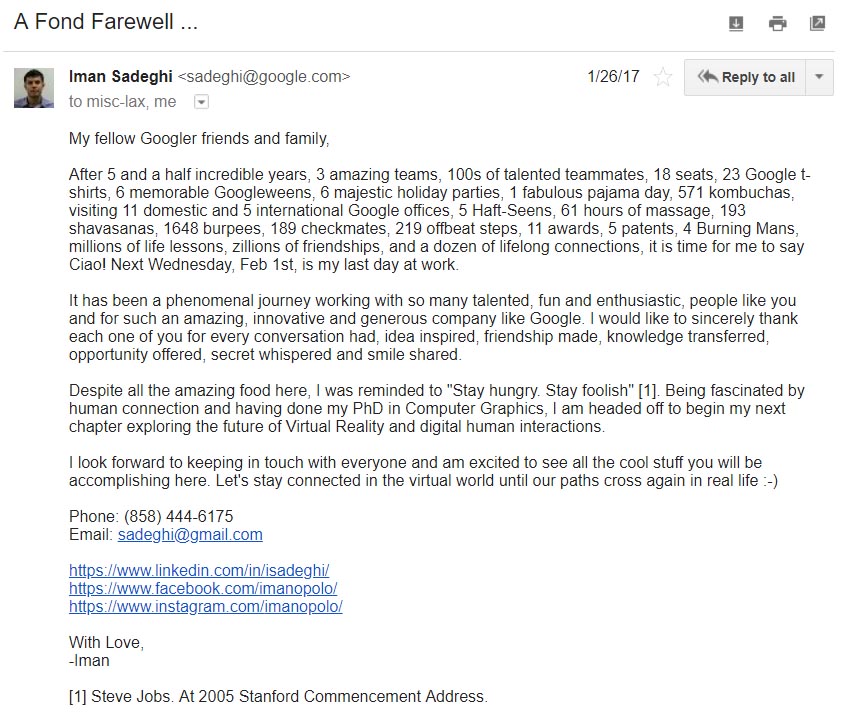
81. Sadeghi would not have resigned from Google to join Pinscreen if Li had not misrepresented and concealed Pinscreen’s data fabrication and academic misconduct from Sadeghi.
82. Sadeghi would not have resigned from Google to join Pinscreen if Li had not concealed Pinscreen’s labor law violations and immigration law violations from Sadeghi.
[ Show Hidden Text ⇓ ]83. Sadeghi was damaged by being fraudulently induced to give up his employment at Google which income and benefits were unsubstituted once Sadeghi was retaliated against and wrongfully terminated from Pinscreen.
84. Sadeghi’s reliance on Li’s representation was a substantial factor in causing him damage.
85. A strong justification for Sadeghi’s reasonable reliance on Li’s misrepresentations was that Li, on information and belief, was and is an assistant professor at USC. Li’s claims to have automated that which he had merely fabricated means that Li has committed academic misconduct which, if discovered, could be subject to draconian punishment.
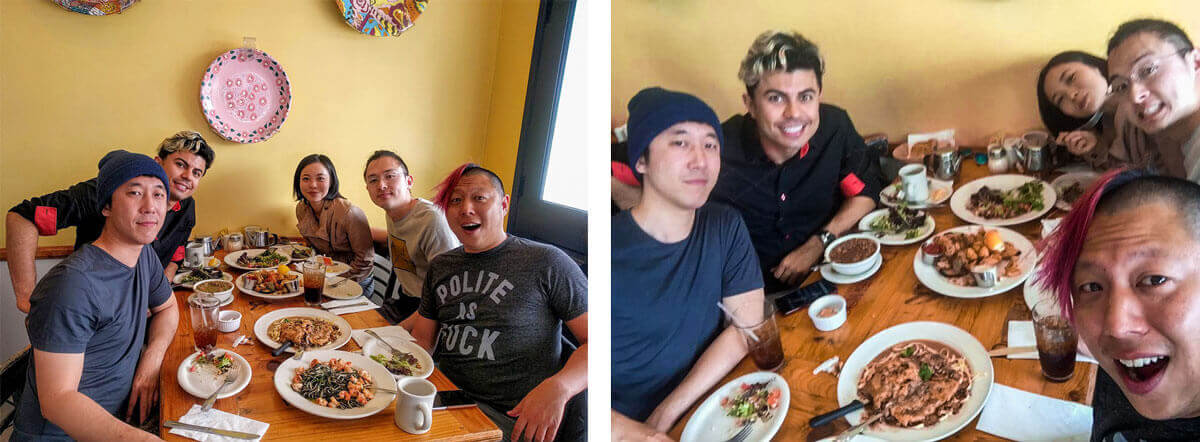
86. During his employment at Pinscreen, Sadeghi significantly improved the quality of Pinscreen’s avatars and digital hair appearance (i.e. hair rendering, or hair shading) from “below the SIGGRAPH standard” to well above.
[ Show Hidden Text ⇓ ]87. Pinscreen’s submission to SIGGRAPH Technical Papers, on January 16, 2017, prior to Sadeghi’s employment, was rejected. One of the reasons for the rejection, given by the conference reviewers, was the poor quality of Pinscreen’s avatars. One of the conference reviewers stated that the quality of Pinscreen avatars were “below the SIGGRAPH standard,” that “a lot of disturbing artifacts can be observed in almost all hair models” and that they “seriously doubt if the quality is good enough for games or VR applications.” (Exhibit D1) Pinscreen’s submission to SIGGRAPH Technical Papers, on January 16, 2017, prior to Sadeghi’s employment, was rejected. One of the reasons for the rejection, given by the conference reviewers, was the poor quality of Pinscreen’s avatars. One of the conference reviewers stated that the quality of Pinscreen avatars were “below the SIGGRAPH standard,” that “a lot of disturbing artifacts (e.g. in regions around the silhouette) can be observed in almost all hair models” and that they “seriously doubt if the quality is good enough for games or VR [Virtual Reality] applications.” (Exhibit D1)


88. For the SIGGRAPH Asia Technical Papers submission, on May 23, 2017, Sadeghi implemented a variation of his published hair appearance framework which significantly improved the quality of Pinscreen’s avatars. This submission was consequently accepted. The quality improvement in the submission was so significant that the conference reviewers asked Pinscreen for an explanation on “why the quality is so improved comparing [sic] with previous submission?” Pinscreen’s official response stated that “in this submission, hair shading has been significantly improved using a variant of Sadeghi 2010 (used in Disney’s Tangled) and […].” (Exhibit D2) For the SIGGRAPH Asia Technical Papers submission, on May 23, 2017, Sadeghi implemented a variation of his published hair appearance framework which significantly improved the quality of Pinscreen’s avatars. This submission was consequently accepted. The quality improvement in the submission was so significant that the conference reviewers asked Pinscreen for an explanation on “why the quality is so improved comparing [sic] with previous submission”? Pinscreen’s official response stated that “in this submission, hair shading has been significantly improved using a variant of Sadeghi 2010 (used in Disney’s Tangled) and […].” (Exhibit D2)

89. The following diagram compares the quality of Pinscreen’s avatars before and after Sadeghi’s contributions to Pinscreen’s digital hair appearance: (Exhibit D3) The following diagram compares the quality of Pinscreen’s avatars before and after Sadeghi’s contributions to Pinscreen’s digital hair appearance: (Exhibit D3)
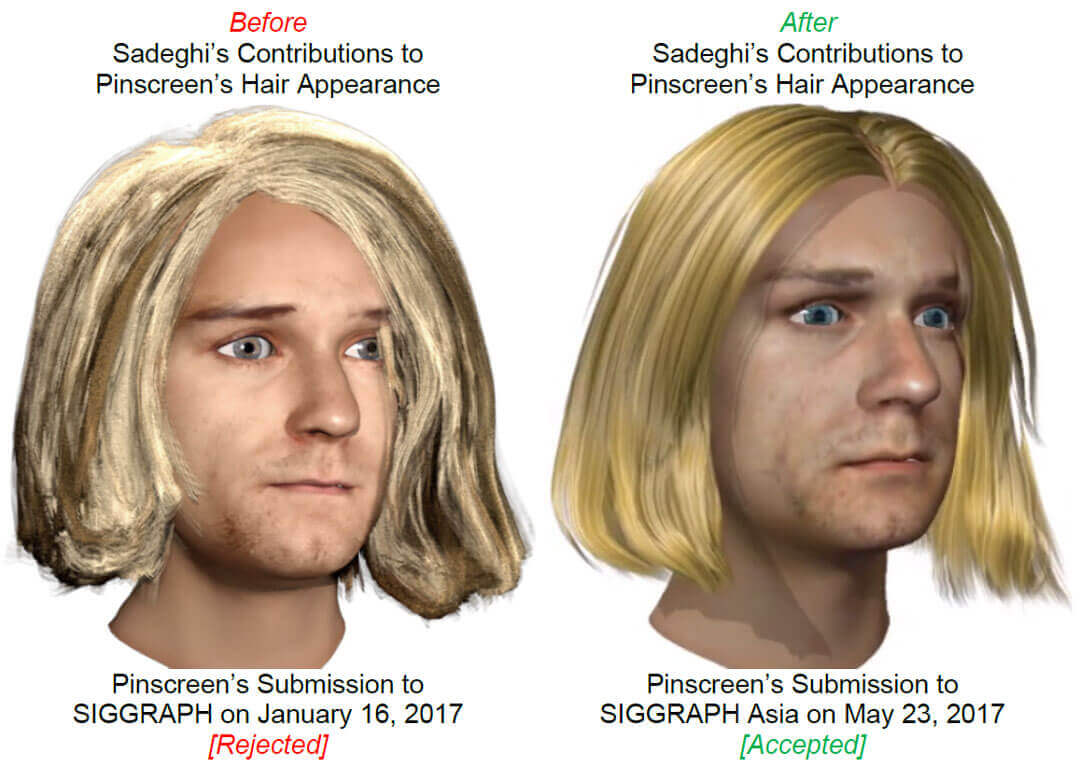
90. Sadeghi also innovated an approach to use Deep Convolutional Neural Networks and Artificial Intelligence (“AI”) to obtain Semantic Constraints for the hair (e.g. hair length, hair curliness, etc.) from the input image in order to enhance the accuracy of the automatically estimated hair shapes. (Exhibit D4)
91. In preparation for Pinscreen’s SIGGRAPH Asia 2017 publication, on April 18, 2017, Saito, who later became a first author of the publication, told Li, through Skype messages, that Sadeghi’s approach for “Semantic Constraints could add biggest contribution” to the publication. Li also considered Sadeghi’s approach to be a competitive edge and stated “we need to make sure that people cannot easily implement it.” (Exhibit D5)
92. Sadeghi improved Pinscreen’s core infrastructure through his contributions to its System Architecture, Software Code Health, Software Codebase Structure, System Security, User Interface/User Experience, and Mobile Apps Framework. (Exhibits D6, D7, D8, D9, D10, D11)
93. Sadeghi created the most comprehensive product description and roadmap for, on information and belief, Pinscreen’s main product at the time, Pinmojis. Pinmoji, which stands for Pinscreen Emoji, is a term Sadeghi coined and popularized within the company. (Exhibit D12)
94. Sadeghi supervised individual employees, coordinated multiple teams, and planned product launches and deliverables for Pinscreen. Sadeghi’s direct reports included Pinscreen’s CTO, Fursund. (Exhibits D13, D14, D15, D16)
95. During Sadeghi’s meeting with Li, on March 9, 2017, Li stated that Sadeghi was “one of the most important hires for Pinscreen,” that Sadeghi “brought structure and energy to the team” and that Li “couldn’t be happier” with Sadeghi’s employment.
96. Additionally, Sadeghi provided assistance and guidance to other Pinscreen employees. For example, the day before his personal anniversary vacation, Sadeghi worked an 18-hour shift, alongside Nagano, to investigate an issue with computation of lights described by Spherical Harmonics (“SH”). In order to make sure that the issue was resolved, Sadeghi worked overnight until after sunrise the next morning, on July 14, 2017, which enabled Pinscreen to demonstrate dynamic lighting during its SIGGRAPH 2017 RTL demo. (Exhibit D17)

97. After joining Pinscreen, Sadeghi gradually realized that Li, although an assistant professor, disrespected academics and was involved in data fabrication and various academic misconduct. (Exhibit E1)
98. [February 4, 2017] Li: “Just a bunch of academic loosers [sic] 😊”

99. Li would embellish Pinscreen’s technical capabilities in scientific research submissions and then use deadline pressure to overwork the employees to achieve his inflated claims, and if the employees eventually failed, he would order them to fake the deliverables.
100. Li discussed ways to “tweak data to get the results we want” and referred to data fabrication as “faking things,” “cheating,” “shitty cheating,” and “doing it manually.” Li mandated data fabrication by stating that he “doesn’t think we can make it automatic,” that “we probably have no choice but to cheat,” and that he thinks “it’s the only way.” (Exhibits E2, E3, E4, E5, E6, E7, E8)
101. [June 29, 2017] Li: “I’m really worried that nothing will work by tje [sic] rehearsal and we have to [sic] some shitty cheating again.”

102. Li’s Skype profile with Skype ID “hao.li.ethz”:
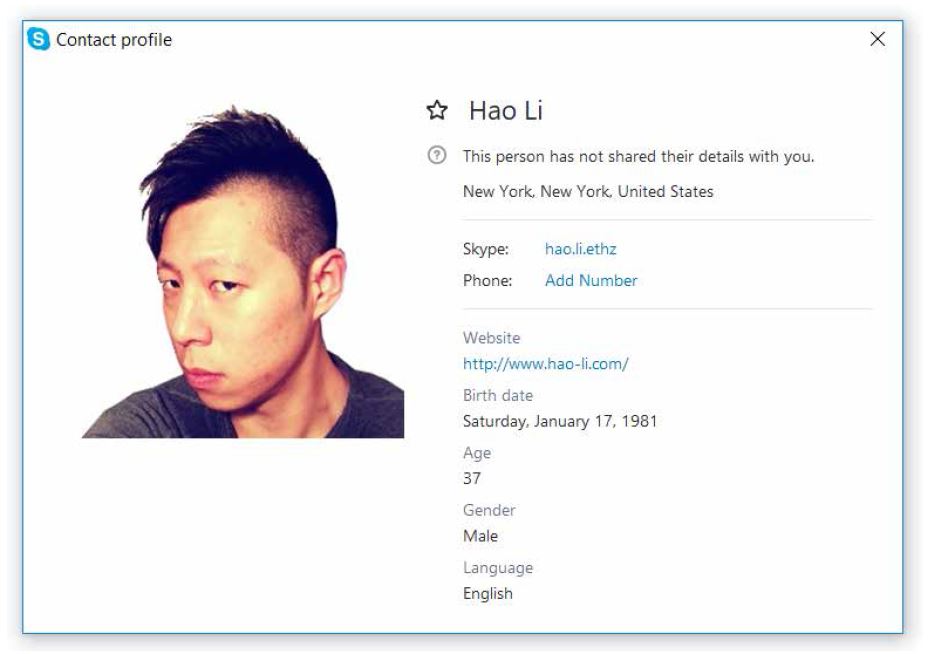
103. Li’s data fabrication and academic misconduct was a deception of the public, fraud on company’s actual and potential investors, violation of the universally accepted scientific code of conduct, and a betrayal to academics. On information and belief, these fabrications have resulted in scientific publications, technical demos and news articles, which have given Pinscreen an advantage in the competitive market by attracting millions of investor dollars to the company and away from its competitors. (Exhibit E9)
104. On information and belief, Pinscreen employees considered Li a role model when it came to conducting scientific research, including the ethics of it. These employees knew about and aided and abetted Li in misrepresenting Pinscreen’s avatar generation results.
105. Under Li’s leadership, Pinscreen intentionally misrepresented manually prepared data as automatically generated in various scientific and business presentations. This dishonest practice is universally recognized by academic ethics codes as data fabrication and data falsification, which are also universally condemned as academic misconduct. Data fabrication and data falsification are classified as “Research Misconduct,” and instances of “Scientific Misconduct,” by USC’s official policy and are in violation of ACM’s “Code of Ethics and Professional Conduct.” (Exhibit E41)
[ Show Hidden Text ⇓ ]106. Pinscreen misrepresented manually prepared data as automatically generated in its SIGGRAPH Real-Time Live ("RTL”) submission on April 4, 2017.
107. Pinscreen misrepresented manually prepared data as automatically generated in its SIGGRAPH Asia Technical Papers submission on May 23, 2017.
108. Pinscreen misrepresented manually prepared data as automatically generated in its SIGGRAPH RTL public demo on August 1, 2017.
109. Pinscreen misrepresented pre-cached avatars as real-time and brand-new from the webcam in its SIGGRAPH RTL public demo on August 1, 2017.
110. Pinscreen misrepresented the speed of its avatar generation of around a minute and half as around 5 seconds in its SIGGRAPH RTL public demo on August 1, 2017.
111. Pinscreen misrepresented manually prepared data as automatically generated in its representations to the investment firm Softbank.
112. Shortly after joining Pinscreen, Sadeghi realized that under Li’s leadership, Pinscreen included fabricated and falsified results in their SIGGRAPH Technical Papers submission, submitted on January 16, 2017, prior to Sadeghi’s employment. In that scientific research submission, among other misrepresentations, Pinscreen had misrepresented manually prepared hair shapes as automatically generated. This submission was eventually rejected and later re-submitted to SIGGRAPH Asia 2017 Technical Papers.
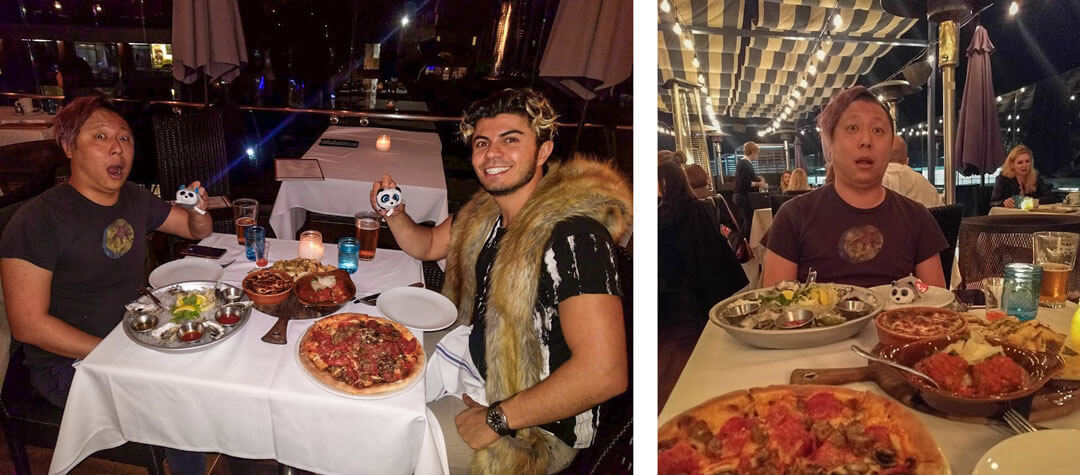
113. When Sadeghi questioned Li about these misrepresentations, for instance on March 9, 2017, Li claimed that they were “not important” because the submissions were “not public.” Li stated that Pinscreen had been practicing the strategy of “Fake it ‘til you make it” and declared that “it has been working great.” Li claimed that should Pinscreen’s fabricated submissions be accepted, Pinscreen would have sufficient time to actually develop the claims before publication. Li claimed that it was crucial to the success of Pinscreen to get into these conferences for industry exposure. Li stated that scientific publications and technical presentations would result in media coverage by technology news outlets, such as TechCrunch, and will substantially “increase the valuation of the company.” Li later claimed similar statements, writing “TechCrunch coverage should be our target.” (Exhibit E10)
114. [May 22, 2017] Li: “TechCrunch coverage should be our target”


115. In preparation for SIGGRAPH RTL submission, due on April 4, 2017, Li wrote on multiple team threads, on March 27, 2017, that “the issue is that we don’t have time,” and that “even if we fake things there is no time,” and that for the hair reconstruction (i.e. hair shape estimation) “we probably have no choice but to cheat.” (Exhibits E3, E7)
[ Show Hidden Text ⇓ ]116. [March 27, 2017] Li: “Even if we fake things there is no time”
117. [March 27, 2017] Li: “The reconstruction part we probably have no choice but to cheat”
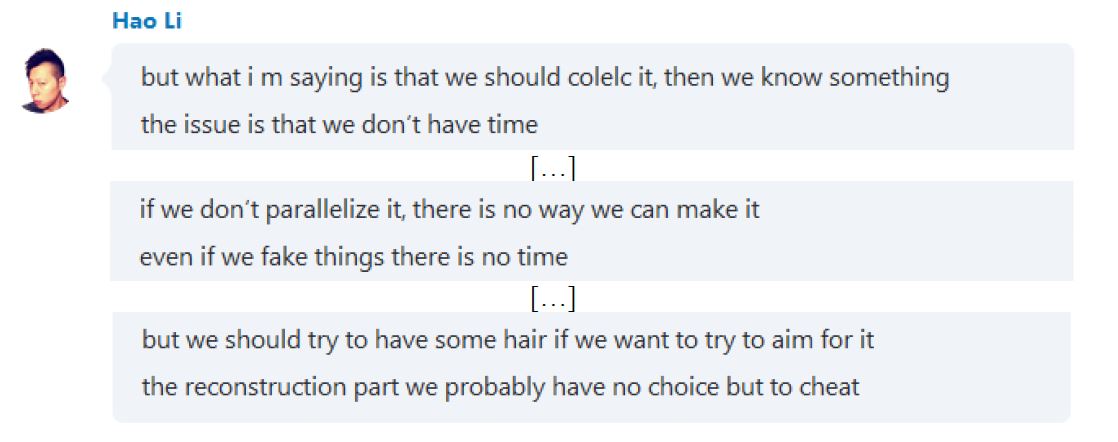
118. Among other misrepresentations in the submission, on information and belief, Li commissioned a freelance artist, located in Germany, named Leszek, to manually prepare the hair shapes for all avatars presented in the submission. On March 30, 2017, Li stated that it would take “3 hours” for an artist to create a hair shape and the cost would be “100 Euros.” Pinscreen misrepresented these hair shapes as automatically generated, when in fact they were created through this lengthy and expensive manual process. (Exhibit E11)
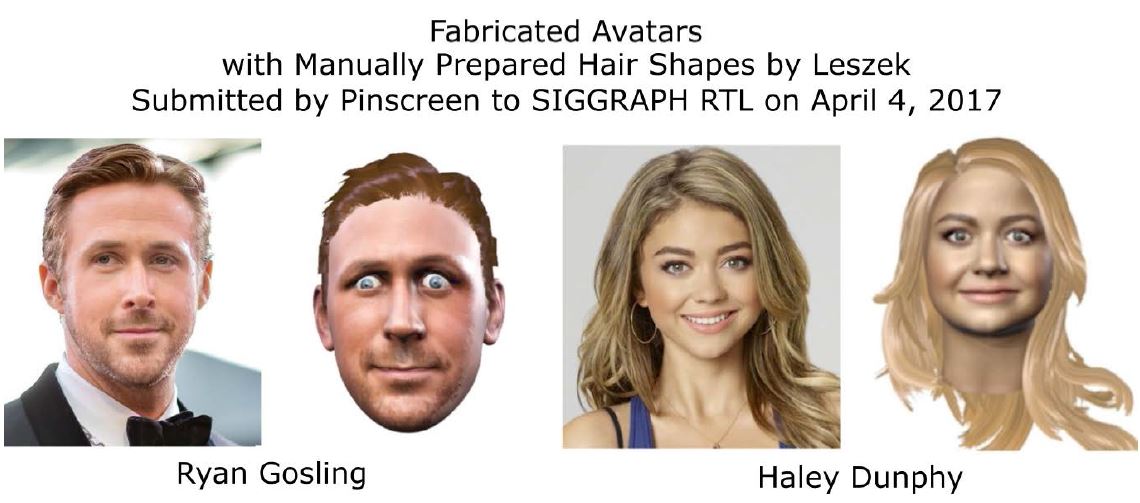
119. On April 18, 2017, Leszek shared his manually prepared hair shapes for Ryan Gosling’s and Hailey Dunphy’s avatars with Sadeghi: (Exhibit E11)
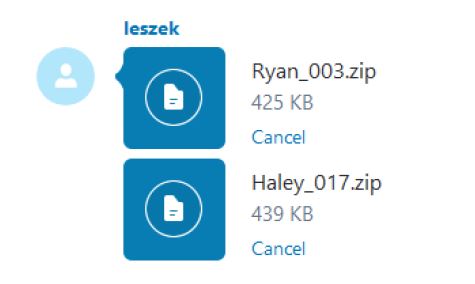
120. Leszek’s Skype profile with Skype ID “spawnie76”:
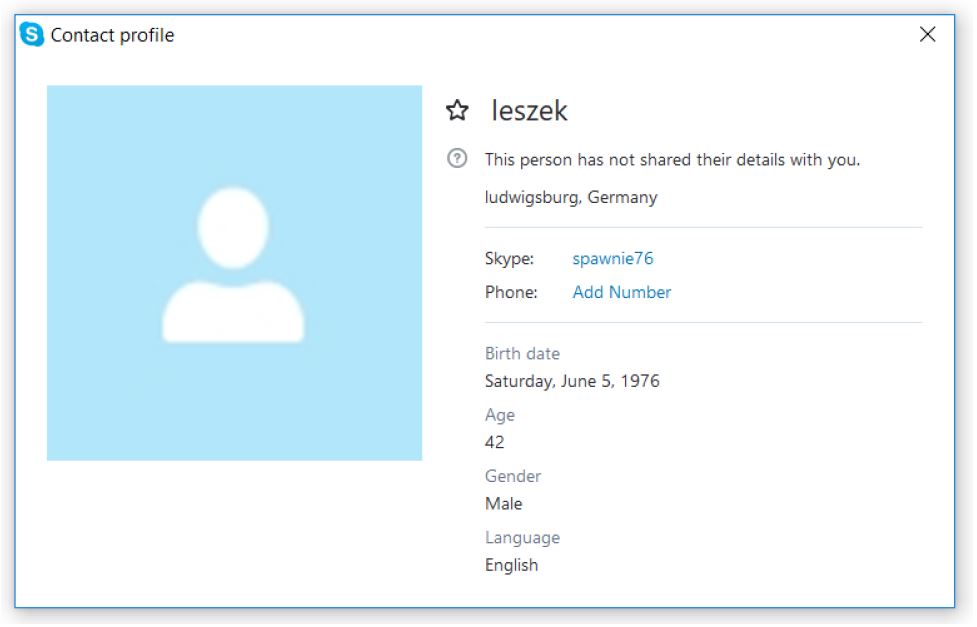
121. Pinscreen’s technology has been and still is, nearly a year and a half after the submission, incapable of automatically generating hair shapes with intricacies demonstrated in Leszek’s hand-made hair shape for Haley Dunphy’s avatar. (Exhibit K2)
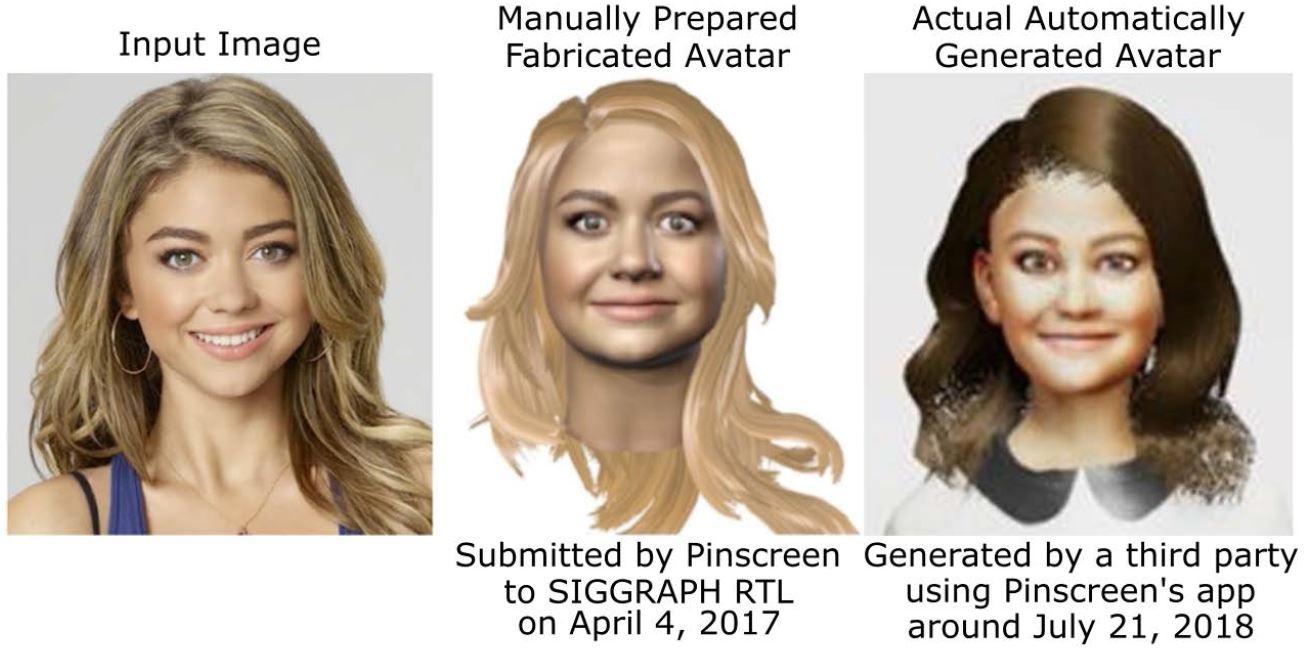
122. In the submission, Li also misrepresented Pinscreen’s speed of avatar generation as “seconds,” which is a speed that Pinscreen was still unable to achieve nearly four months later, for its SIGGRAPH RTL public demo, on August 1, 2017, where the true speed of avatar generation was around a minute and a half. (Exhibits E12, E27)
123. On April 4, 2017, Pinscreen, under Li’s leadership, submitted fabricated avatars with manually prepared hair shapes created by Leszek to SIGGRAPH RTL.
124. Pinscreen’s submission to SIGGRAPH 2017 RTL; titled “Pinscreen: Creating Performance-Driven Avatars in Seconds”; co-authored by Li, Saito, Wei, Sadeghi, Hu, Seo, Nagano, Fursund, Yen-Chun Chen, and Stephen Chen; containing fabricated avatars with manually prepared hair shapes; published on ACM Digital Library:
125. https://dl.acm.org/citation.cfm?id=3107546

126. Pinscreen revised its previously rejected submission to SIGGRAPH 2017 Technical Papers and resubmitted it to SIGGRAPH Asia Technical Papers, on May 23, 2017.
127. For the resubmission, Pinscreen was asked to present 100 avatars for 100 input images. (Exhibit E13)
128. Li commissioned artists to manually prepare hair shapes for the requested avatars and misrepresented them in the submission as automatically generated.
129. Li stated, on April 18, 2017, “then I have an artist create 100 hairs ahahaha,” and on May 17, 2017, “basically, I need to create 3D hair models for 100 people or get 3D modelers to do it.” (Exhibits E14, E15)
[ Show Hidden Text ⇓ ]130. [April 18, 2017] Li: “Then I have an artist create all 100 hairs”
131. [April 18, 2017] Li: “Ahahaha”
132. [May 17, 2017] Li: “So basically I need to create 3D hair models for 100 people”
133. [May 17, 2017] Li: “Or get 3D modelers to do it”
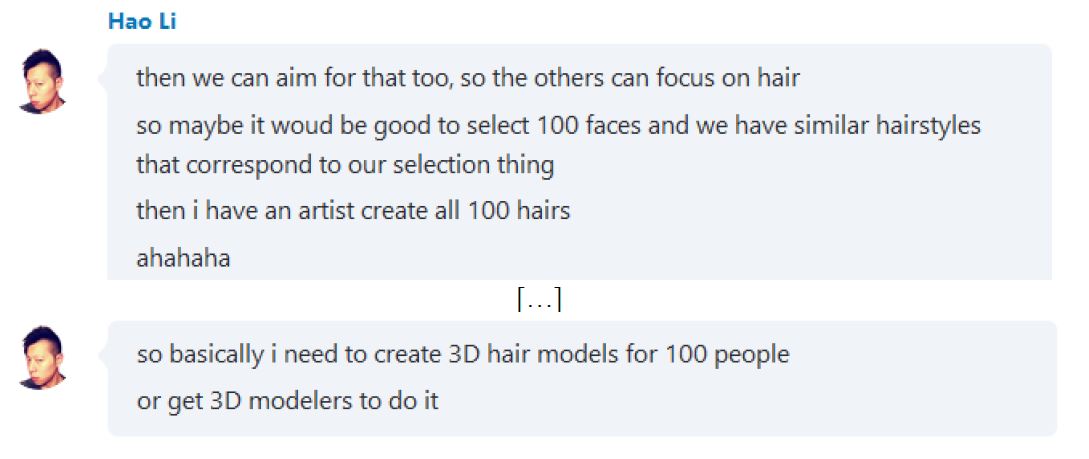
134. Pinscreen also fabricated the process of estimating the eye color in the submission. On May 18, 2017, five days before the submission deadline, Li stated that Pinscreen’s eye color estimation was “total shit,” “completely random” and ordered Pinscreen employees to “manually fix all the eye colors” for the avatars. Pinscreen then fraudulently claimed in the publication that “several key components, such as […] eye color recognition, are only possible due to recent advances in deep learning.” (Exhibits E6, E16, E17, E18, E19, E20)
[ Show Hidden Text ⇓ ]135. [May 15, 2017] Li: “Our eyes are wrong”
136. [May 15, 2017] Li: “The colors”
137. [May 15, 2017] Li: “We need to use a Deep Neural Net for that”
138. [May 15, 2017] Li: “Or we just do it manually for SIGGRAPH Asia for now”
139. [May 15, 2017] Li: “Let s [sic] do it manually for now”
140. [May 15, 2017] Li: “I think it s [sic] the only way”
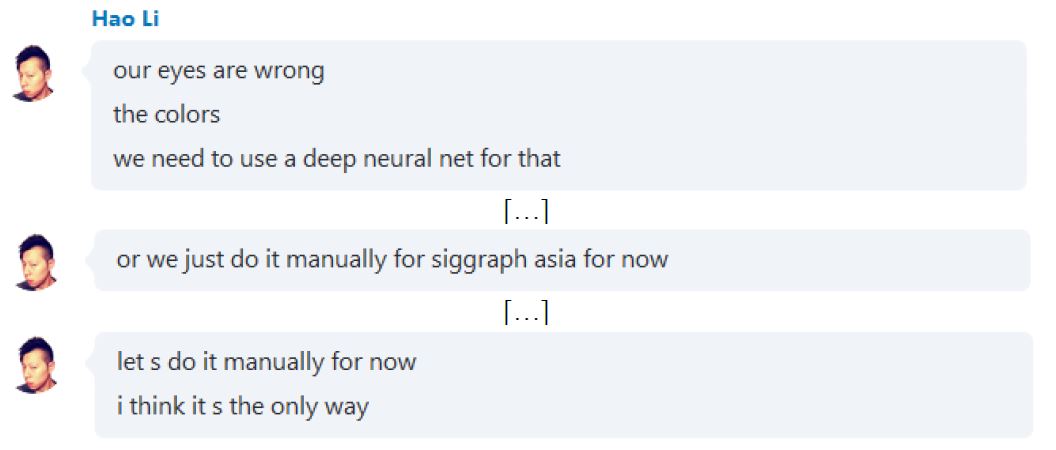
141. [May 18, 2017] Li: “The eye color is total shit”
142. [May 18, 2017] Li: “It s [sic] completely random”
143. [May 18, 2017] Li: “I would say let s [sic] do them manually for now”
144. [May 18, 2017] Li: “Okay so I m [sic] generating all the avatars”
145. [May 18, 2017] Li: “We need someone to manually fix all the eye colors”
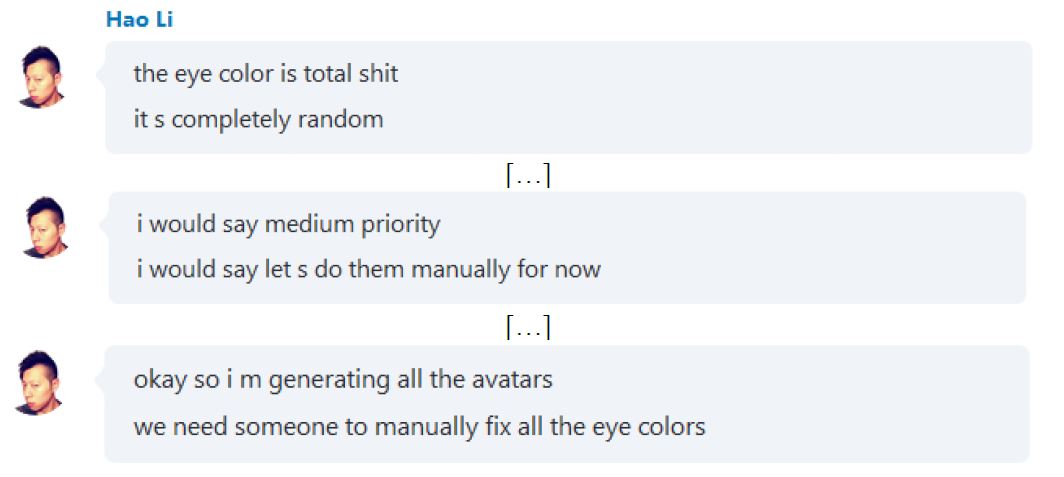
146. In addition, Pinscreen fabricated the process of estimating the hair color in the submission. On May 18, 2017, five days before the submission deadline, Li stated, “we also have nothing that can guess hair color.” Subsequently, Pinscreen’s CTO, Fursund, was assigned the task to “manually pick up hair color” for the avatars. Pinscreen then fraudulently stated in the submission that “the eye color texture is computed using a similar convolutional neural network […] as the one used for hair color classification.” (Exhibits E18, E21, E22)
147. Pinscreen misrepresented other manually prepared data as automatically generated in its submission including, on information and belief, the “focal length” estimation, a sub component of face shape estimation, and “hair segmentation,” a sub component of hair shape estimation. (Exhibits E19, E21)
[ Show Hidden Text ⇓ ]148. [May 19, 2017] Hu: “Anther [sic] thing missing is the hair segmentation”
149. [May 19, 2017] Hu: “Now the current automatic segmentation results are not always very good”
150. [May 19, 2017] Hu: “So I think we need [sic] manually refine them”

151. On May 22, 2017, one day before the submission deadline, Li ordered the team, on “PinscreenTeamAll” Skype thread, including Saito, Nagano, Wei, Yen-Chun Chen, Hu, Fursund, Sun, Kung, Seo, Yu, Xiang, Stephen Chen, Zhou, and Sadeghi to fabricate the Hair Polystrip Patch Optimization process stating “we spent 1 day on it,” that is a lot, and that “if in an hour it’s not working, let’s do it manually and give up on it. I don’t think we can make it automatic.” (Exhibit E8)
152. [May 22, 2017] Saito: “Is the patch optimization working now?”
[ Show Hidden Text ⇓ ]153. [May 22, 2017] Nagano: “There are several issues in error computation and we are testing a new approach”
154. [May 22, 2017] Yen-Chun Chen: “@Hao Li asking @Koki Nagano Liwen [Hu] does the thing work?”
155. [May 22, 2017] Hu: “There is another bug”
156. [May 22, 2017] Li: “>_<”
157. [May 22, 2017] Li: “Will you guys have it in an hour?”
158. [May 22, 2017] Li: “We spent 1 day on it. that s a o;t [sic]”
159. [May 22, 2017] Li: “lot”
160. [May 22, 2017] Nagano: “The gamma or something is only off for dark values”
161. [May 22, 2017] Li: “What s [sic] the current ETA?”
162. [May 22, 2017] Li: “I need it to see if we shoudn’t [sic] do something else?”
163. [May 22, 2017] Li: “We are late by 6 hours”
164. [May 22, 2017] Li: “We almost don’t hzve [sic] time to produce results and write the paper”
165. [May 22, 2017] Li: “If in an hour it s [sic] not working let s [sic] do it manually
166. [May 22, 2017] Li: “And give up on it”
167. [May 22, 2017] Li: “I don’t think we can make it automatic”
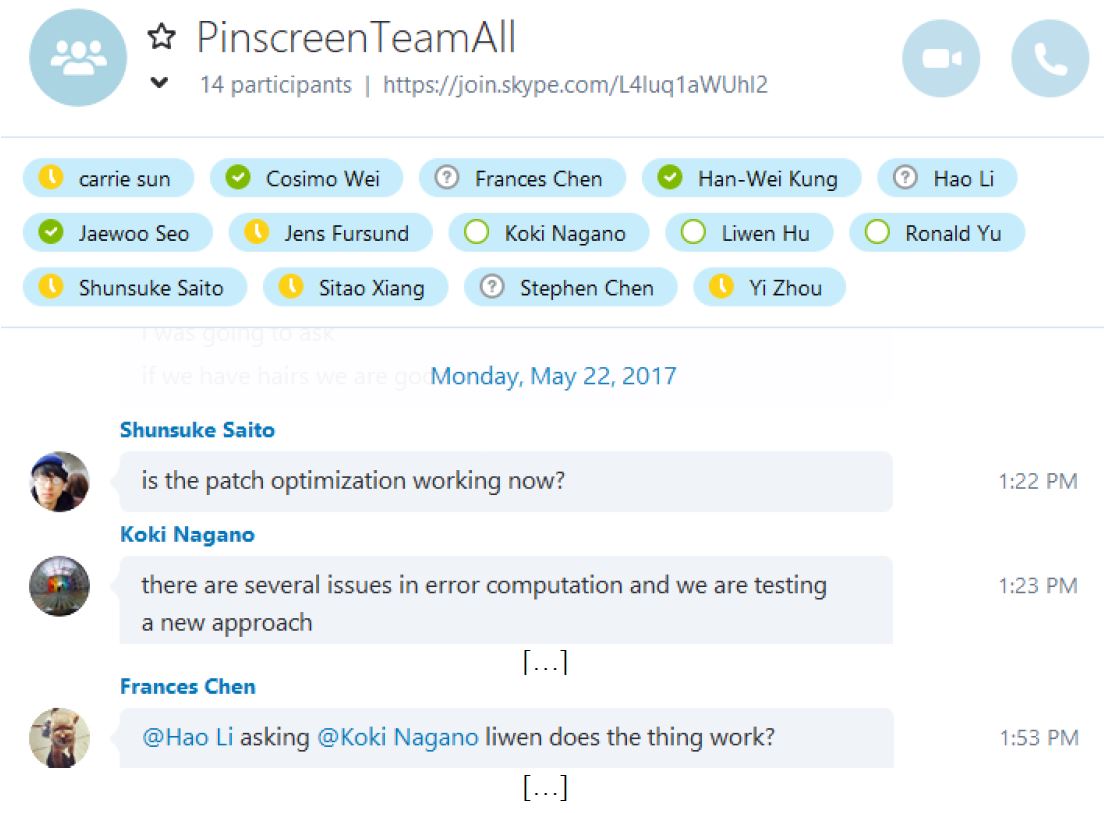
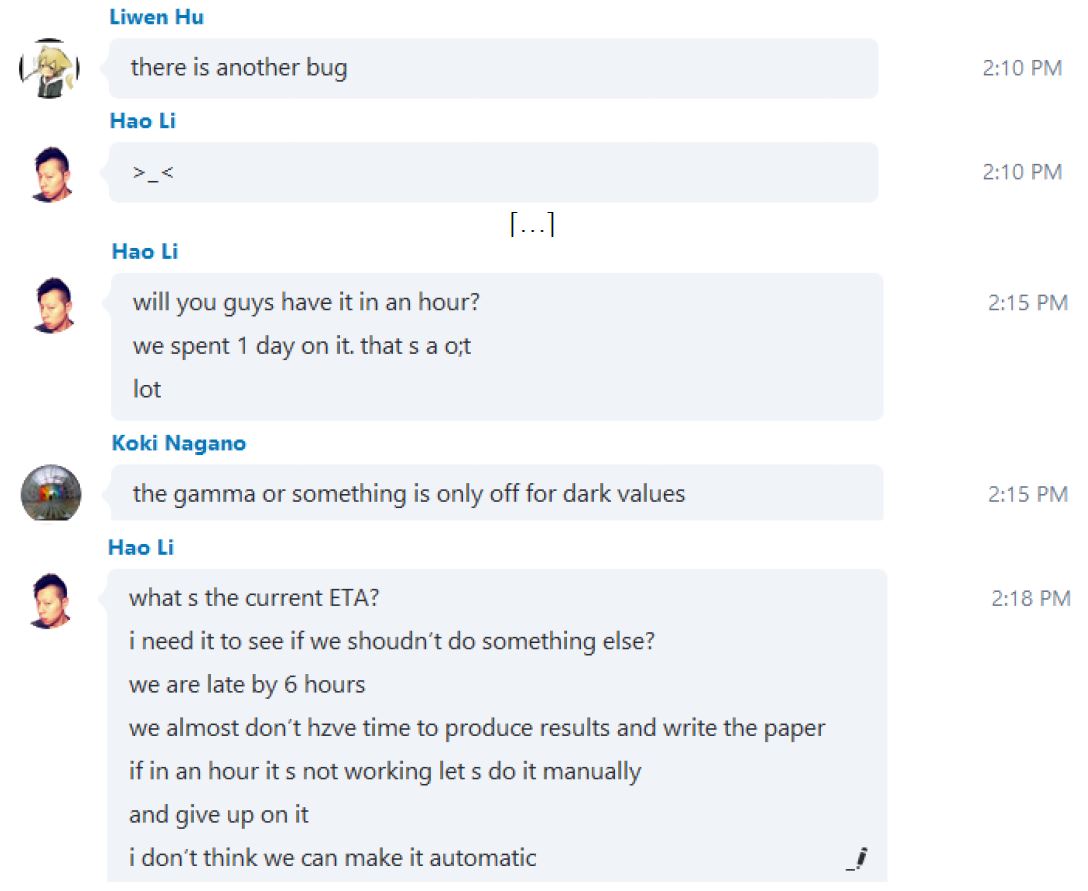
168. On May 23, 2017, Sadeghi confronted Li regarding the data fabrication and academic misconduct committed in Pinscreen’s SIGGRAPH Asia 2017 Technical Papers submission. Li stated that he wanted “Pinscreen to be the first” in research and the industry. Li claimed that by the time of the conference, in November of 2017, Pinscreen would have had a public product launch and would have achieved Li’s embellished claims in the submission. Sadeghi asked Li, “what if for unforeseeable reasons we don’t have everything by then?” Li promised Sadeghi that Pinscreen’s data fabrication would be limited to nonpublic representations and never shown in public and stated:
169. [May 23, 2017] Li: “We won’t present something we don’t have”
170. On May 23, 2017, Pinscreen, under Li’s leadership, submitted fabricated avatars with manually prepared eye colors, hair colors, and hair shapes to SIGGRAPH Asia.
171. Pinscreen’s SIGGRAPH Asia 2017 Technical Paper; titled “Avatar Digitization from a Single Image for Real-Time Rendering”; co-authored by Hu, Saito, Wei, Nagano, Seo, Fursund, Sadeghi, Sun, Yen-Chun Chen, and Li; containing fabricated avatars with manually prepared eye colors, hair colors and hair shapes; published on ACM Digital Library:
172. https://dl.acm.org/citation.cfm?id=31310887
173. After the filing of the complaint, the Los Angeles Times reported, on June 20, 2018, that Li told its reporter, on a phone interview, that Pinscreen’s app is “proof that Pinscreen’s technology works.” However, third parties have produced evidence that Li’s proof is inadequate since Pinscreen’s app produces inferior results compared to Pinscreen’s representations. The following figure compares one of Pinscreen’s fabricated avatars with manually prepared eye color, hair color, and hair shape in the submission (middle) to Pinscreen’s actual automatically generated avatar produced by a third party more than a year after the submission using Pinscreen’s app (right). Pinscreen’s actual automatically generated hair shape, hair color, eye color and overall avatar is inferior to its prior fabricated representations. (Exhibits K1, K2)
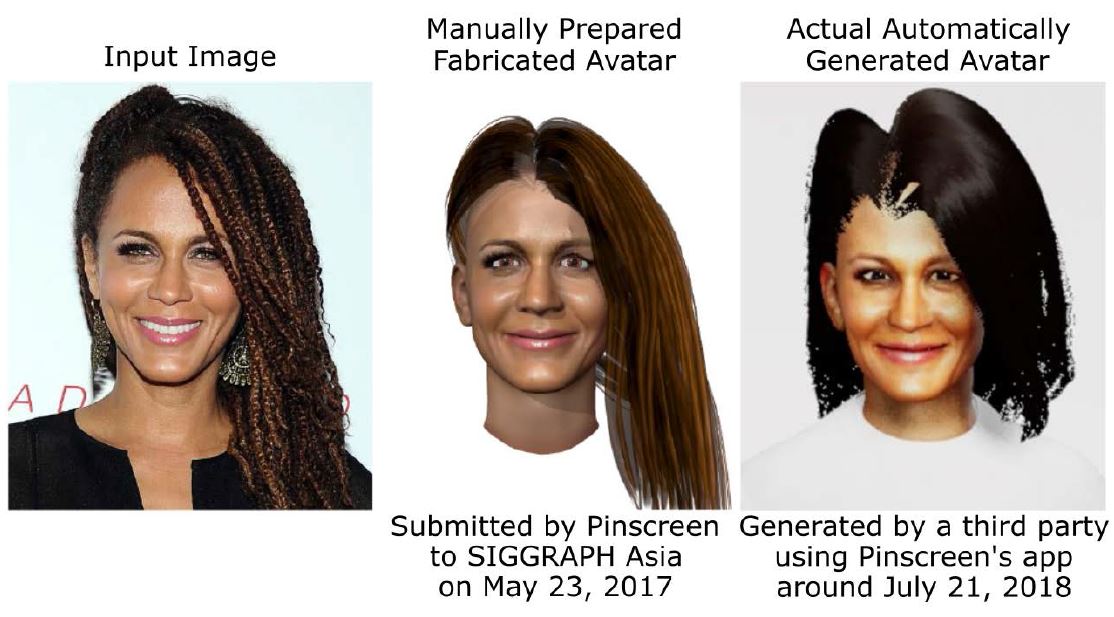
174. Li considered SIGGRAPH Real-Time Live (“RTL”) as the “best event at SIGGRAPH,” “the hardest thing to get in,” and “the only show that matters at SIGGRAPH.” Li claimed that RTL gets “much more visibility than papers” and emphasized that “there will be TechCrunch at SIGGRAPH RTL.” (Exhibits E10, E23)
175. However, as Pinscreen approached the RTL public presentation date of August 1, 2017, on information and belief, Li realized that Pinscreen would not be able to deliver on Li’s inflated claims put forth in the submission, months earlier on April 4, 2017, despite Pinscreen employees’ long hours and hard work. Li stated, on June 29, 2017, that he was “really worried that nothing would work” by the RTL rehearsal and that Pinscreen would have to do “some shitty cheating again.” (Exhibit E5)
[ Show Hidden Text ⇓ ]176. The title that Li had chosen for the RTL demo, months earlier on April 4, 2017, was “Pinscreen: Creating Performance-Driven Avatars in Seconds.” In reality, however, Pinscreen’s avatar generation would take around a minute and half to execute which was, on information and belief, comparable to the performance of competitors such as Loom.ai. (Exhibits E12, E24, E27)
177. Additionally, the accuracy of Pinscreen’s hair shape estimation was far from Li’s inflated claims in Pinscreen’s RTL submission, since each purportedly automatic hair shape had been manually prepared by the freelance artist Leszek.
178. The allocated time for Pinscreen’s RTL demo was 6 minutes, and Li planned to show multiple avatar generations within 2 minutes. Sadeghi suggested that “if we don’t generate a brand-new avatar,” the avatar can be cached. Pre-caching results, i.e., computing them beforehand and storing them for quick access, is a common custom and practice while presenting technical demos with limited time. However, scientific ethics require that the fact that an element is pre-cached should always be disclosed. (Exhibit E25)
179. While Sadeghi was away on vacation, Li decided to misrepresent pre-cached avatars as real-time during Pinscreen’s public demo at SIGGRAPH Real-Time Live, on August 1, 2017, to an audience of thousands. In Sadeghi’s absence, Li revealed his intention to deceive the RTL audience, in writing, on July 20, 2017, when he proposed on “PinscreenTeamAll” Skype thread that Pinscreen would “give the people the feeling the avatar is not pre-built” and that “we should give them a sense that it is computing.” In reality, the avatars were pre-built and pre-computed. Li’s decision to fabricate data in a public presentation was in violation of the law and his promise to Sadeghi. (Exhibit E26)
[ Show Hidden Text ⇓ ]180. [July 20, 2017] Sun: “Plus with many images, if we fake the loading time, it can add up”
181. [July 20, 2017] Li: “I think file load is reasonable because it give [sic] the people the feeling the avatar is not pre-built”
182. [July 20, 2017] Li: “We should give them a sense that it is computing”
183. [July 20, 2017] Li: “If it s [sic] just loaded it s [sic] not impressive”
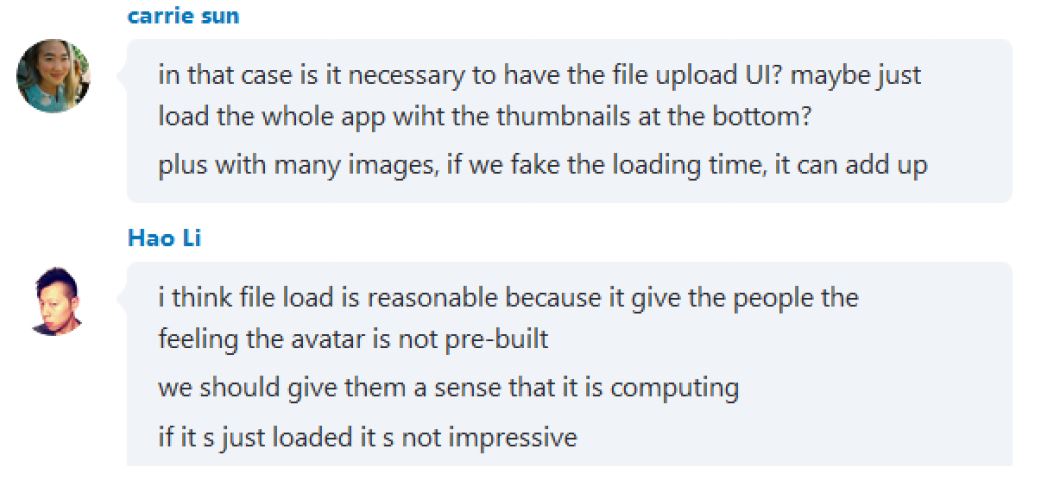
184. On July 22, 2017, upon returning from his anniversary vacation, Sadeghi met other Pinscreen employees at a scientific conference in Hawaii. Sadeghi tested Pinscreen’s avatar generation and reported on “PinscreenTeamAll” Skype thread that it took around a minute and half. Sadeghi’s report also indicated that the automatically estimated hair shape was not accurate and represented a different hairstyle. (Exhibit E27)
185. [July 22, 2017] Sadeghi: “The creation took ~90 seconds.”
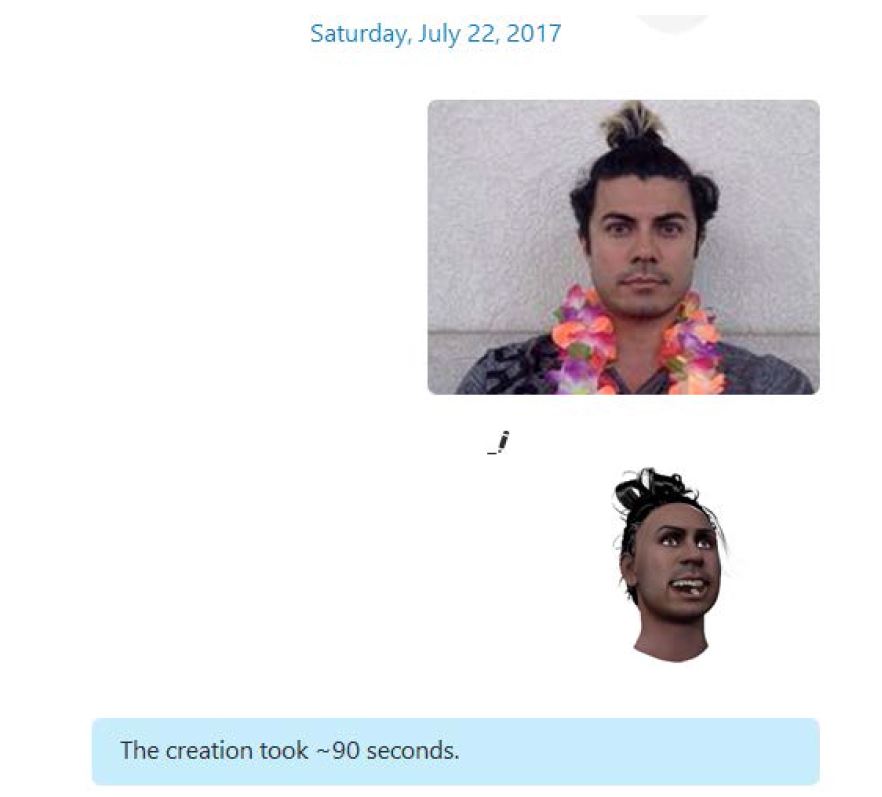
186. Sadeghi’s Skype profile with Skype ID “iman.sadeghi”:
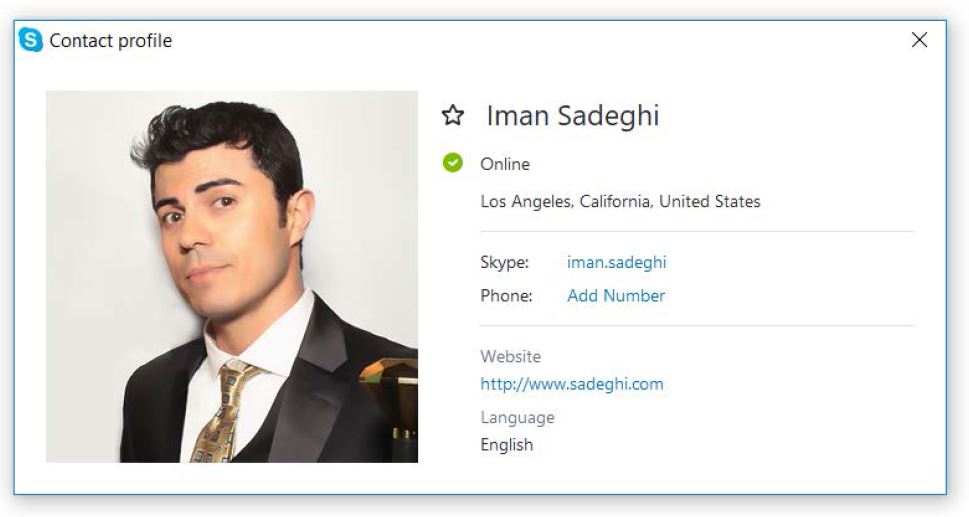
187. Shortly after, Sadeghi messaged Li to clarify Li’s plan to present a brand-new avatar generation from the webcam at the RTL demo. Sadeghi informed Li that the speed of avatar generation was around a minute and half and that there was “some risk for a hairstyle miss” meaning inaccurate hair shape estimation. Li did not respond to Sadeghi’s message: (Exhibit E28)
188. [July 22, 2017] Sadeghi: “So for the live webcam avatar generation at RTL, are you [Li] thinking we will compute everything from scratch (~90 seconds now with some risk for a hairstyle miss) or we cache some stuff?”
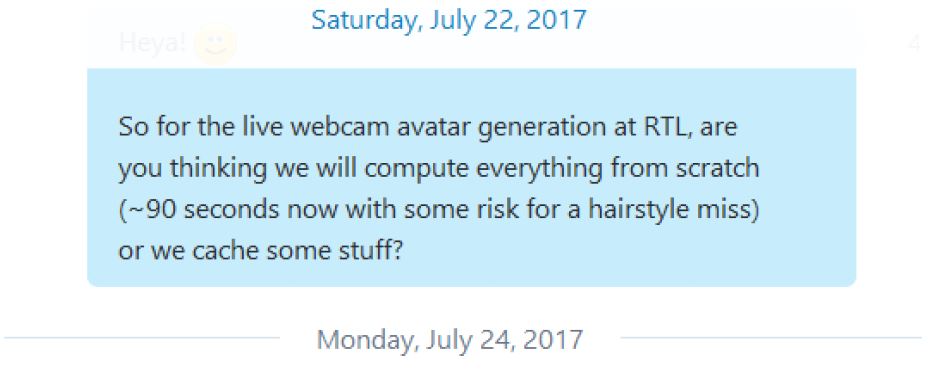
189. Later that evening, on July 22, 2017, Sadeghi met with Li who disclosed his plan to fabricate the webcam avatar generation and its speed by misrepresenting pre-cached manually prepared avatars as brand-new, automatic, and real-time. Sadeghi confronted Li and stated that Pinscreen should be truthful to the public and scientific community, that Li’s data fabrication could be considered “investment fraud,” and that everyone’s “academic reputation” at Pinscreen was at stake.
190. Li dismissed Sadeghi’s objections and claimed that the actual speed of Pinscreen’s avatar generation was “too slow,” and that it “won't be impressive,” and therefore Pinscreen could not present it. Li stated that one of his goals was to have “Loom.ai and ObEN to stop even trying to compete with us.” Li expressed concerns that Pinscreen’s actual automatic hair shape estimation could have poor quality and would “make us look bad” and claimed that “Loom.ai will laugh at us.” Li later made similar statements to the team until a few days before the RTL demo. (Exhibit E29)
191. Li claimed that Pinscreen “didn’t have any other choice at that point,” that the decision was made last week, that it was “final,” and that Sadeghi must follow the plan and focus on finalizing the RTL demo.
192. Subsequently, Sadeghi asked Li to promise that moving forward, Pinscreen would stay honest and avoid fabricating its results. Li dismissed Sadeghi’s request and stated, around midnight on July 22, 2017:
193. Li: “Let’s talk about this after the RTL demo.”
194. Sadeghi reluctantly accepted Li’s proposal and focused on finalizing Pinscreen’s RTL demo.

195. On July 24, 2017, Fursund, Pinscreen’s CTO, admitted in writing that Pinscreen was “just using pre-cached avatars” and therefore “it’s important that we know exactly who is using the webcam to generate the avatar”: (Exhibit E30)
196. [July 24, 2017] Fursund: “Anyway… It’s important that we know exactly who is using the webcam to generate the avatar”
197. [July 24, 2017] Fursund: “Since we’re just using pre-cached avatars”

198. Fursund’s Skype profile with Skype ID “alt_er_ego”:

199. Li defined tasks such as “creating all avatars, hair models, tweak for perfect hair color” and “hair models/avatars” and assigned them to Sun. Pinscreen presented multiple avatars during its RTL demo including an avatar of the program chair Cristobal Cheng (“Cristobal”). Sun manually prepared the hair shapes for many of the avatars presented at RTL, including for Sadeghi’s, Cristobal’s, Nagano’s, and her own avatar. (Exhibit E31, E38, E39, E40)
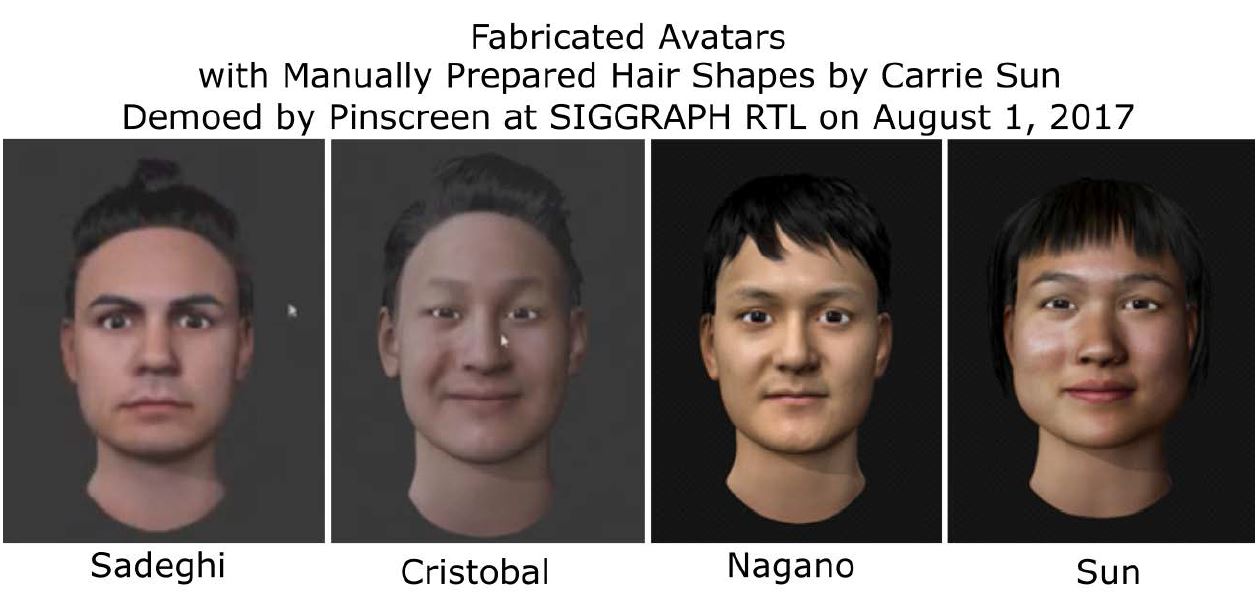
200. On July 25, 2017, 7 days before RTL, Sadeghi gave feedback regarding the hair shapes for Sun’s and Sadeghi’s avatars, which were manually prepared by Sun. Sadeghi wrote to Sun, “you might want to redo the hair for your avatar” and that “around my ears the hair is missing” to which Sun responded “I’ll add the hair around your ears today.” (Exhibits E38, E39)
[ Show Hidden Text ⇓ ]201. [July 25, 2017] Sadeghi: “@Carrie Sun only if you had extra cycles, you might want to redo the hair for your avatar.”

202. [July 25, 2017] Sadeghi: “Looks like around my ears the hair is missing.”
203. [July 26, 2017] Sun: “I’ll add the hair around your ears today”
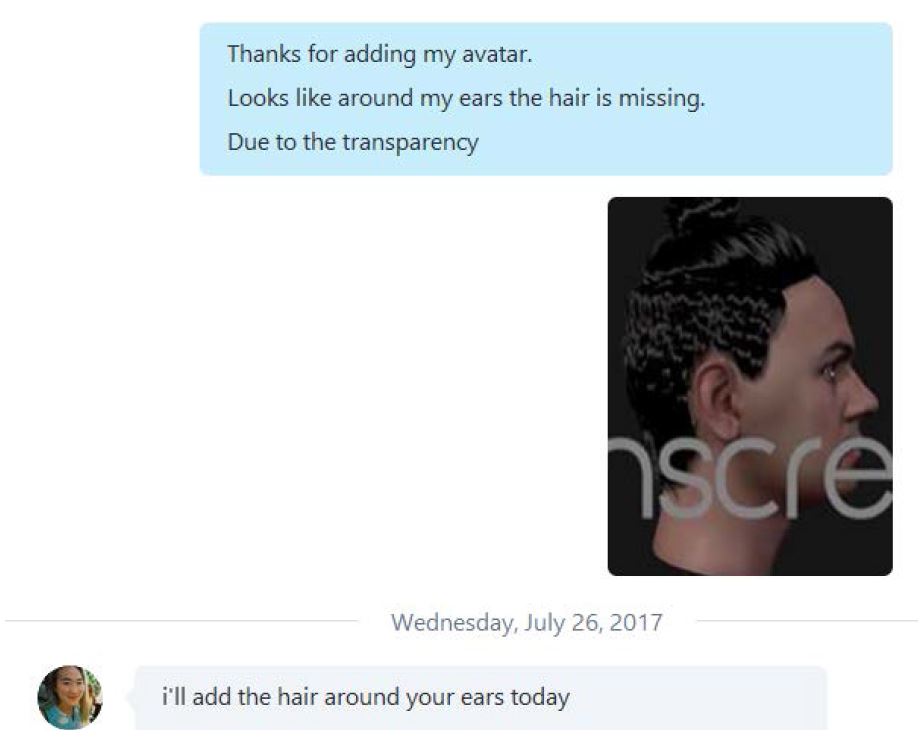
204. On July 26, 2017, 6 days before RTL, Nagano, wrote to Sun, on “PinscreenTeamAll” Skype thread, and requested “for my hair if you can lower it down a bit if it’s not too hard, that would be nice,” and that Nagano doesn’t think his “forehead is that large.” The requested manual modification of the hair shape was done after around 2 days: (Exhibit E31)
[ Show Hidden Text ⇓ ]205. [July 24, 2017] Sun: “I created a hair for Koki [Nagano]’s avatar”

206. [July 26, 2017] Nagano: “Oh and for my hair if you [Sun] can lower it down a bit if it's not too hard, that would be nice. (I don;t [sic] think my forehead is that large 🙂)”
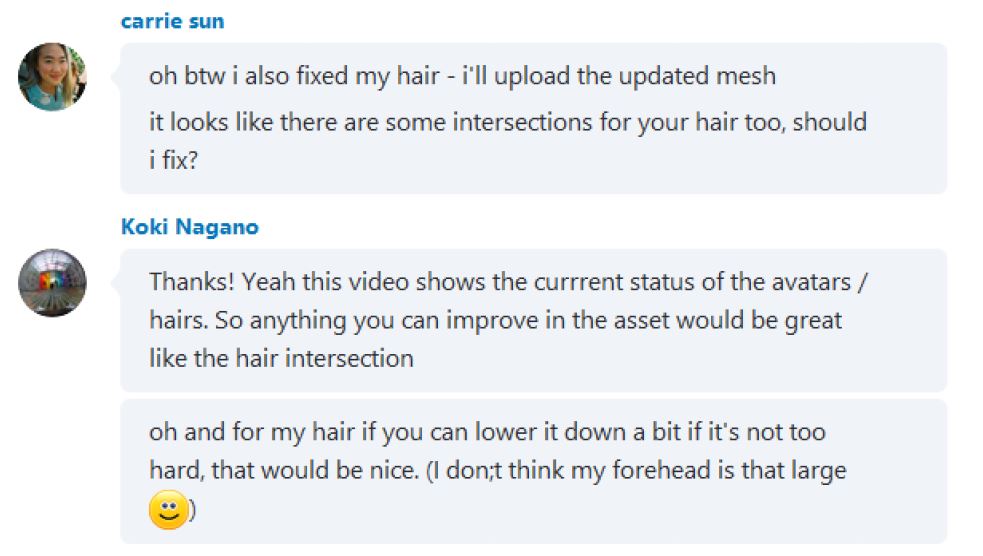
207. [July 28, 2017] Sun: “Koki [Nagano]’s new hair (with fewer intersections in the front) is in the Dropbox folder here:”
208. [July 28, 2017] Sun: “https://www.dropbox.com/home/Pinscreen%20Team%20Folder/SIG17RTL/AvatarCandidates/AvatarData/Koki_new”

209. On July 28, 2017, 4 days before RTL, Sadeghi wrote to Sun, on “PinscreenTeamAll” Skype thread, and requested that she manually add more hair around the ears for Cristobal’s avatar. It took Sun more than 2.5 hours to add the missing hair around Cristobal’s ears. (Exhibit E40)
[ Show Hidden Text ⇓ ]210. [July 28, 2017] Sadeghi: “I am finalizing the avatars. Cristobal hair around his ears can use some love if you have time @Carrie Sun”
211. [July 28, 2017] Sun: “Do you think we’re going to be showing the sides? haa”
212. [July 28, 2017] Sadeghi: “It shows if I rotate him a tiny bit”
213. [July 28, 2017] Sun: “I will be able to do it 😊”
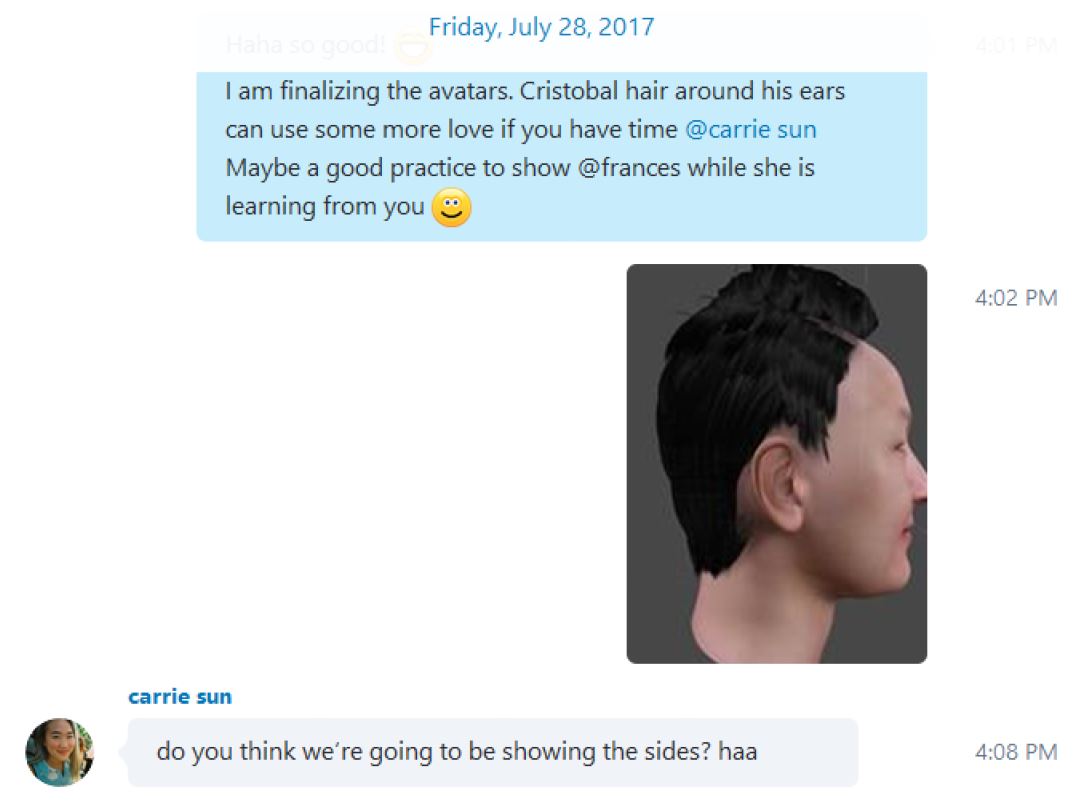
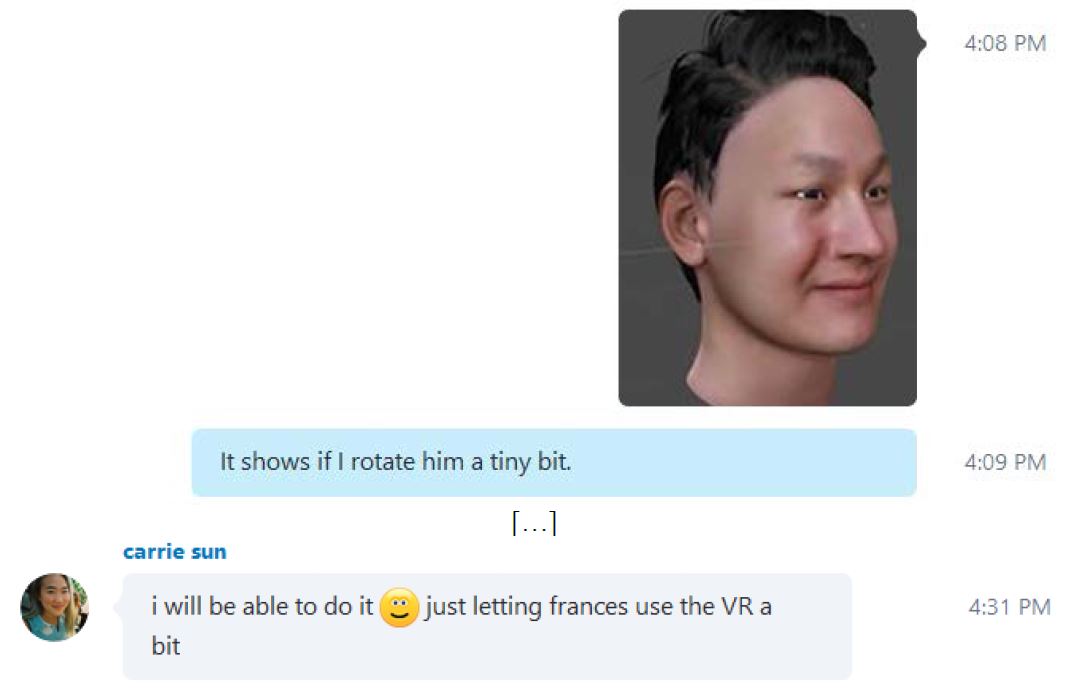
214. Sun’s Skype profile with Skype ID “live:carrie.k.sun”:
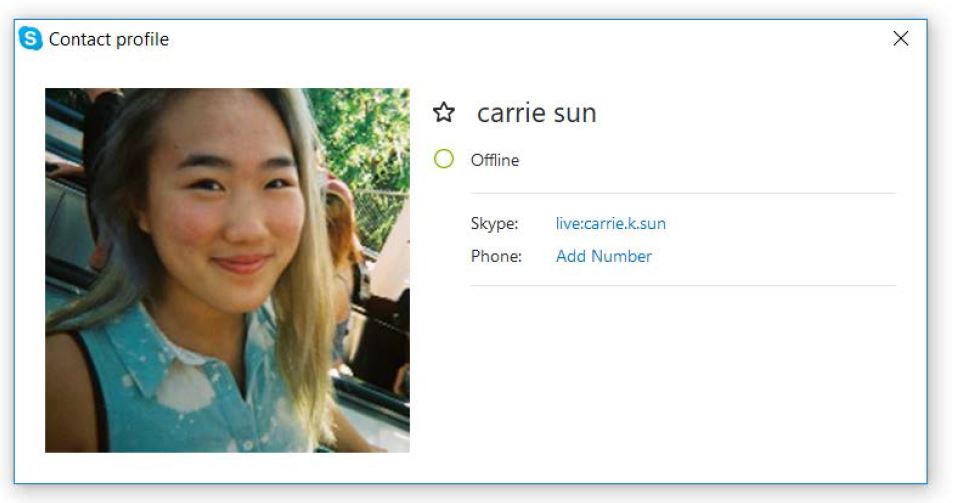
215. On August 1, 2017, Pinscreen, under Li’s leadership, during its SIGGRAPH RTL public demo in front of thousands of attendees and online viewers, misrepresented manually prepared hair shapes as automatic, pre-cached avatars as brand-new and in real-time, and the speed of its avatar generation of around a minute and half as around 5 seconds.
216. Pinscreen’s public demo at SIGGRAPH 2017 RTL, titled “Pinscreen: Creating Performance-Driven Avatars in Seconds” was co-presented by Li, Sadeghi, Nagano, Seo, and Sun and contained fabricated avatars with manually prepared hair shapes. This demo is published on ACM digital library and ACM SIGGRAPH’s YouTube channel:
217. https://dl.acm.org/ft_gateway.cfm?id=3107546&ftid=1920365
218. https://www.youtube.com/watch?v=hpuEdXn_M0Q&t=31m6s

219. After receiving the “Notice of Claim and Litigation Hold” letter from Sadeghi’s counsel, on November 2, 2017, Pinscreen announced inconsistent numbers for its speed of avatar generation compared to what was misrepresented at SIGGRAPH 2017 RTL demo, which was around 5 seconds. For instance, on November 14, 2017, Pinscreen announced that its avatar generation requires around 4 minutes (around 50 seconds in “5X fast forward”) in its “high-quality” setting and that it takes “less than a minute” without the high-quality features. (Exhibit E32)
220. Further evidence confirming Pinscreen’s data fabrication at RTL includes Li’s own testimony. On November 29, 2017, during Pinscreen’s SIGGRAPH Asia 2017 Technical Papers presentation in Thailand, Pinscreen stated that the hair shape estimation subprocess alone required “less than 10 seconds.” After the presentation and during the Q&A session, Li was challenged about Pinscreen’s demonstrated speed of avatar generation at RTL of around 5 seconds. Li was questioned as to how the whole avatar generation process took around 5 seconds at RTL while one of the subprocesses required around 10 seconds by itself. In response, Li blurted out that for RTL “we definitely cached it.” When Li was subsequently questioned “the webcam was cached too?” Li refused to answer the question, headed out of the Q&A session, and proceeded to leave the conference premises, on information and belief, to avoid answering the question.
221. Pinscreen was scheduled to showcase its technology at RTL 2018, more than a year after Pinscreen’s fabricated demo at RTL 2017, and shortly after the media coverage of the lawsuit which accused Pinscreen of misrepresenting manually prepared hair shapes as automatically generated. On August 14, 2018, Pinscreen made no attempts or claims to generate any hair shapes in real-time during its demo and chose to generate only one brand-new avatar from the webcam. For its live webcam avatar generation, Pinscreen chose a bald subject which did not involve any hair shape generation. Subsequently, Pinscreen’s RTL 2018 demo gained around only 5.5% of the popular votes. (Exhibit K3)
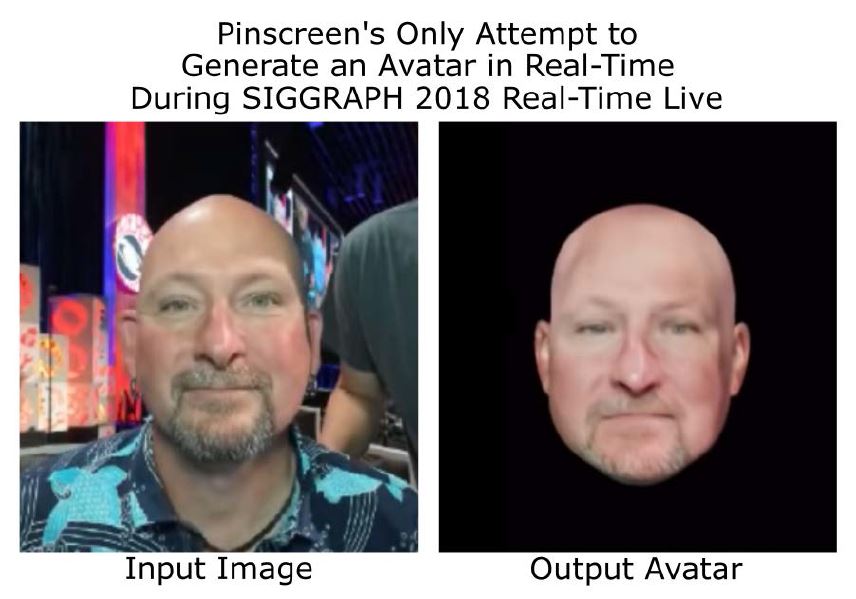
222. Li’s academic misconduct included sharing confidential under-review scientific paper submissions from competitor research groups within Pinscreen and suggesting to look for “details that can be used.” This exploitation of his position as a reviewer violates established scientific ethics. Sharing papers he was reviewing, for his own commercial gain, is another instance of Li’s academic misconduct. (Exhibit E33)
223. Li made public claims about having scientific contributions to the iPhone X until Dr. Sofien Bouaziz (“Bouaziz”), a research scientist from Apple Inc., the manufacturer of the iPhone X, posted on Li’s Facebook on October 25, 2017, suggesting that Li “avoid propagating fake information.” Bouaziz informed Sadeghi during the SIGGRAPH 2018 conference (located in Vancouver, BC on August 13, 2018) that Li unfriended and blocked Bouaziz on Facebook after Bouaziz posted on Li’s Facebook for a second time regarding Li’s repeated misrepresentations of his own contributions to the iPhone X. On information and belief, Li has deleted both Facebook posts by Bouaziz. (Exhibit E34)
[ Show Hidden Text ⇓ ]224. Bouaziz’s post on Li’s Facebook dated October 25, 2017:
225. https://www.facebook.com/li.hao/posts/10155155647648753

226. Li’s data fabrication extended to business representations for investors and venture capitalists (“VCs”), whom Li neither trusted nor respected. For instance, Li misrepresented Pinscreen’s technical capabilities to Softbank by falsely representing manually “picked” hair shapes as automatic. The day the investment agreement between the parties was close to being finalized, Li stated on “PinscreenTeamAll” Skype thread: (Exhibits E35, E36, E37)
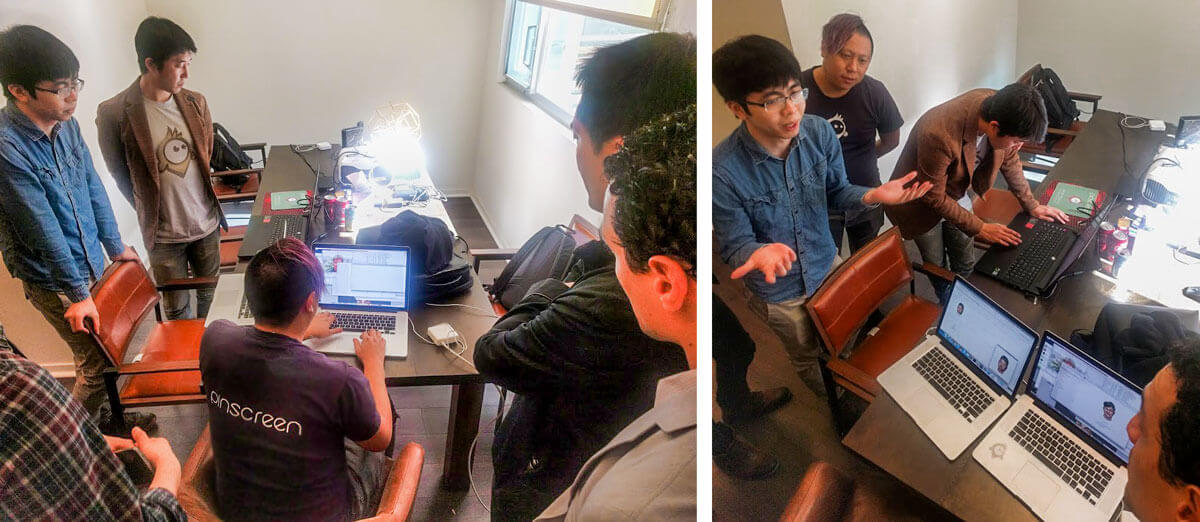
227. [June 17, 2017] Li: “Pinscreen just fucked Softbank”

228. Li used deadline pressure to overwork Pinscreen employees and unlawfully refused to pay them overtime. Li repeatedly asked for updates during the nights, weekends, and expected student employees to work on holidays. For instance, on Father’s Day, Sunday, June 18, 2017, Li wrote to Sadeghi and asked “please push the students more, they are getting lazy and only work half of the day.” (Exhibit F1)
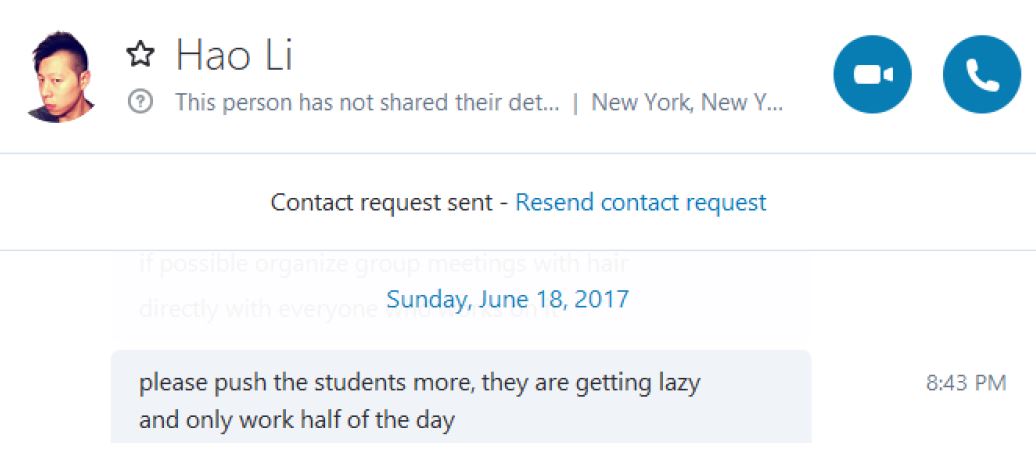
229. When Sadeghi questioned why there was a work-related event on Sunday, April 16, 2017, Li responded on a team thread that we work every day.
230. On June 28, 2017, Sadeghi told Li that some of Pinscreen’s non-exempt employees were working an excessive amount of overtime and should be properly compensated. Li dismissed Sadeghi’s proposal, telling him that “the students are used to working this many hours” and that “the employees are salary based and are being paid enough already.”
231. Li told Sadeghi, in the same meeting, that “deadlines are a tool to push the students to work more. Without deadlines they won’t work on the weekends and nights.” Li also suggested Sadeghi to push Pinscreen employees to work more “as long as they don’t die from Karōshi.” Karōshi is a Japanese term literally meaning “overwork death.” Another related Japanese term used by Li was Salaryman which refers to employees who “are expected to work long hours, additional overtime, […] and to value work over all else.” (Exhibits F2, F3)
232. While unlawfully refusing to pay overtime, Li posted on his Facebook about overworked Pinscreen employees, who were passed out on couches inside Pinscreen’s office, referring to them as “casualties.” Li referred to Saito, as “Salariman [sic]” multiple times. Li also publicly paid tribute to death from overwork on his Facebook, posting “Karoshi! Let me tell you! Sleep is for the weak.” (Exhibits F4, F5, F6)
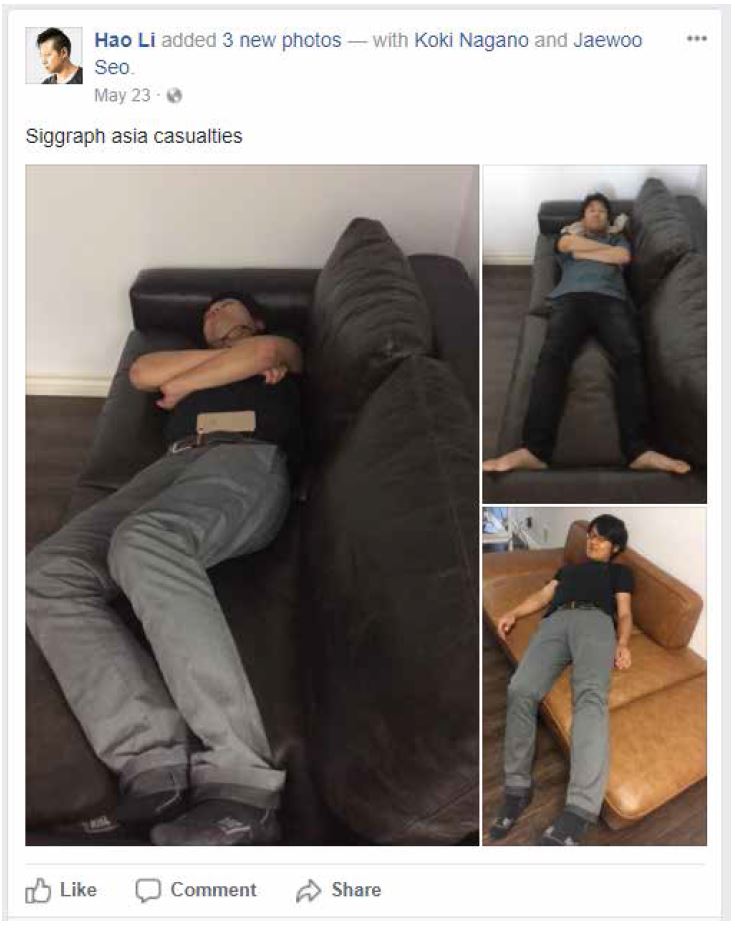
233. Sadeghi dined with Seo and Nagano on July 24, 2017, during a scientific conference in Hawaii. During the dinner, they told Sadeghi about their excessive amount of overtime work without receiving any financial compensation from the company. Seo further stated that he and Nagano “have no life” and that this amount of work “would not be sustainable.” Later, both of the employees confirmed in writing that they had each worked, on average, around 110 hours per week for the months of May, June, and July of 2017. Sadeghi promised them he would talk to Li after the SIGGRAPH Real-Time Live demo and try to persuade him to pay overtime and “to make sure we are fair to everyone.” (Exhibits F7, F8)

234. [August 6, 2017] Sadeghi: “Hey my man Jaewoo [Seo], what would be your best estimate on the average hours you worked per day/week in the past 3 months and upto RTL? 😊”
235. [August 7, 2017] Seo: “I don't know. Maybe around 100-120 hrs/wk? :-[“
236. [August 7, 2017] Sadeghi: “Yes that's a lot of hours. Alright cool. Will talk to Hao [Li] today to make sure we are fair to everyone. Especially the full time employees 😊”
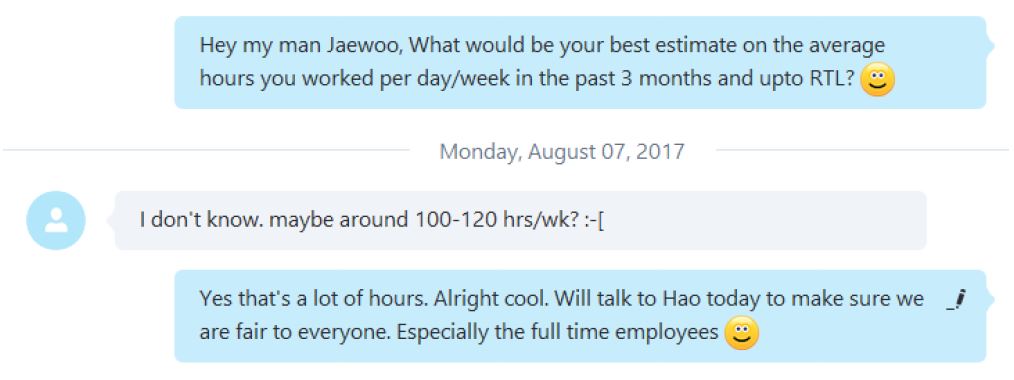
237. Additionally, Li harassed, bullied, and discriminated against a Pinscreen employee who it was generally assumed among employees to suffer from autism-spectrum disorder. Li stated, on June 23, 2017, that the employee “should not be autistic” and that it will be Li’s “new project” to teach him “manners.” Li stated that the employee allegedly “does not have the ability to respond,” does not behave “like an adult,” and that Li feels like he “is talking to a wall” when he is talking to the employee. Li verbally abused the employee and used demeaning language such as “are u [sic] fucking shitting me???” and “we are not fucking paying u [sic] for that!” when addressing the employee. Sadeghi requested on June 28, 2017 that Li be respectful towards the employee, but Li dismissed Sadeghi’s request, stating that the employee is “used to it” and that the demeaning language was how Li was able to “push them to work more.” (Exhibit F9)
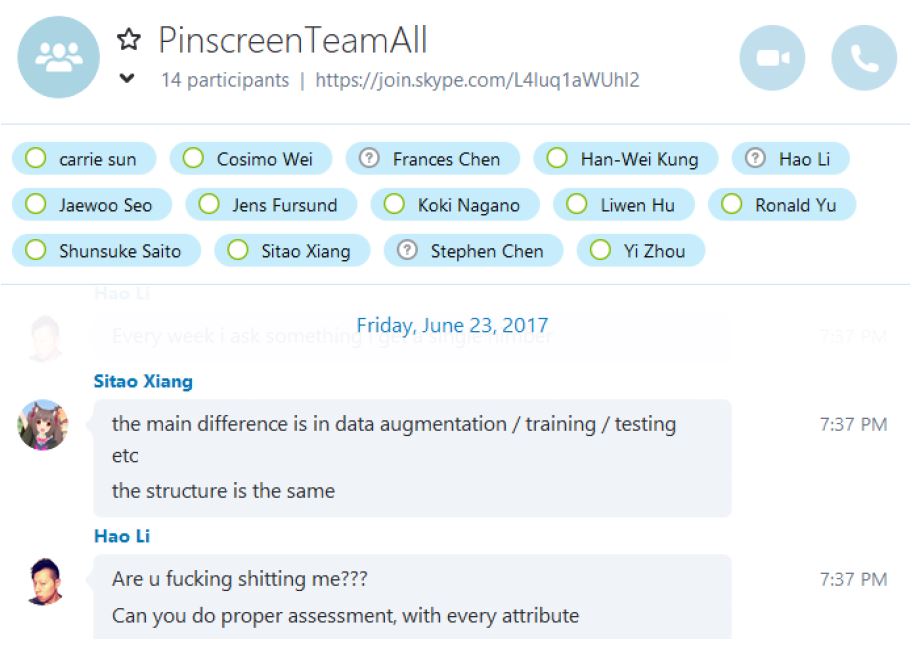
238. Furthermore, Li discussed firing Pinscreen’s CTO, Fursund, while he was expecting a newborn. Li claimed that if Li and Sadeghi do not check on Fursund, “he is just doing nothing,” and that “Jens [Fursund] is sick at every deadline we have.” Li stated, “out of a sudden [sic] he [Fursund] had a child” and attributed Fursund’s alleged lack of performance to having a baby. On information and belief, Li’s resentment toward Fursund was because Fursund prioritized his family over work during the weekends. Li told Sadeghi that Fursund was a “bad hombre” because “he doesn’t work on the weekends.” Li later claimed, on May 23, 2017, that “Jens [Fursund]’s baby has cost Pinscreen a shit ton of money.” In order to clarify Fursund’s performance, Sadeghi suggested that Li ask Fursund to share detailed progress reports with Li and Sadeghi. Furthermore, Sadeghi suggested that Li “make sure he [Fursund] doesn't feel micromanaged or disrespected.” (Exhibits F10, F11)
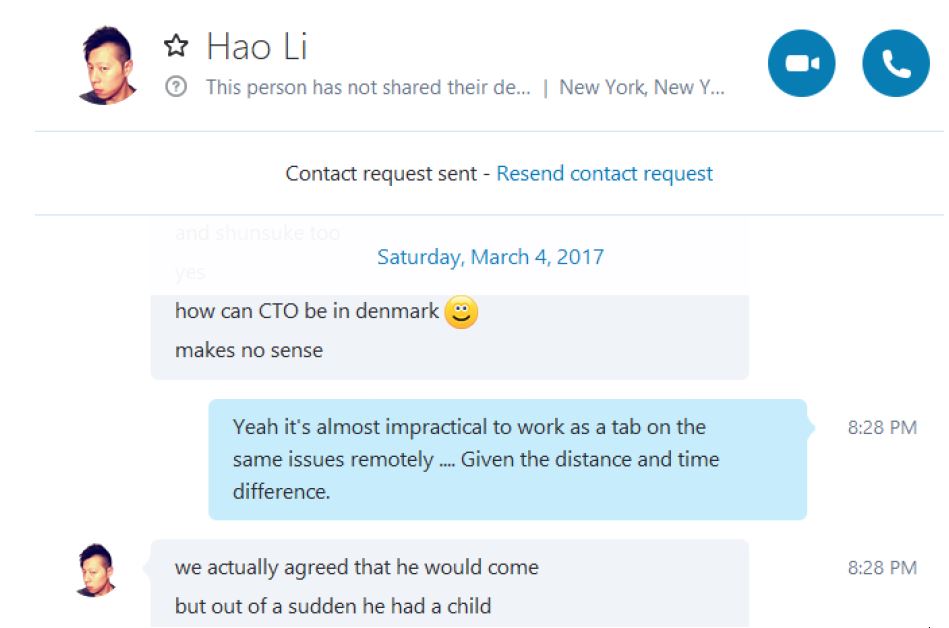
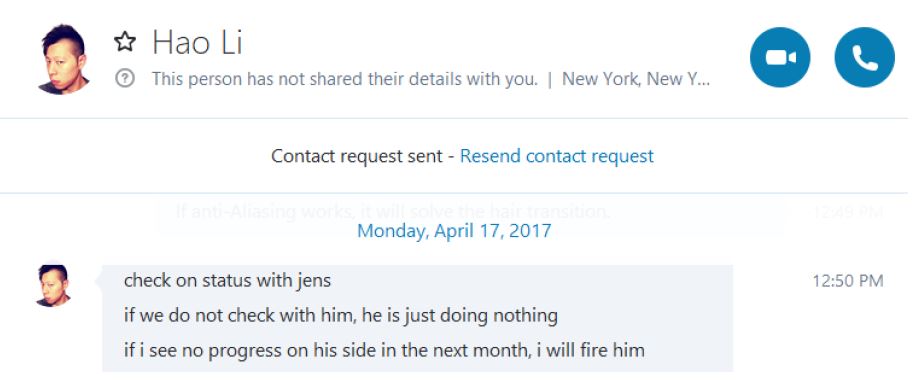
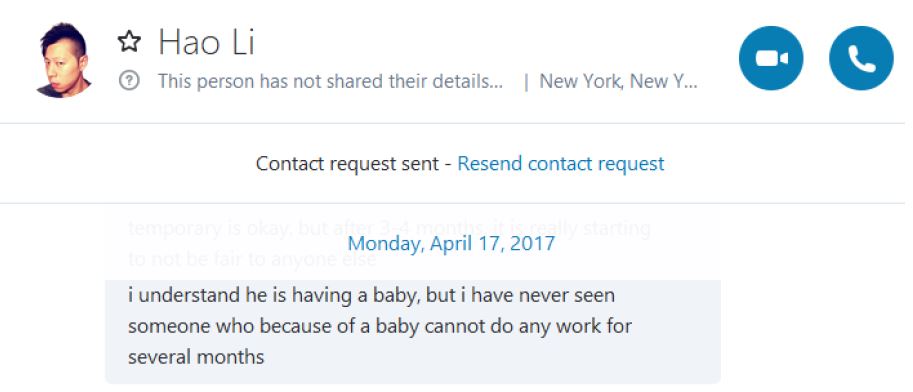
239. Pinscreen committed further labor law violations after wrongfully terminating Sadeghi by withholding his business expense reimbursements in violations of California Labor Code § 2802. Pinscreen also phrased the purpose of a check mailed to Sadeghi for late wage payment penalties as a settlement offer “to resolve any wage issues,” in violation of California Labor Code § 203.
240. On information and belief, Li was ineligible to work at Pinscreen as its CEO and has performed work for the company illegally because Li did not have a work visa for Pinscreen. On information and belief, Li is not a US Citizen, his permanent residency (i.e. green card) application has been rejected, and he lacks a proper visa to perform any role at Pinscreen. On information and belief, Li has an H-1B visa sponsored by USC, which only allows him to work at the university and not at Pinscreen. In response to Sadeghi’s inquiry about Li’s work authorization and eligibility, Li claimed that he does not need a visa to work for Pinscreen because he is not receiving any salary from the company. Li’s working at Pinscreen without a proper visa would violate the Immigration Reform and Control Act of 1986.
[ Show Hidden Text ⇓ ]241. On information and belief, Li pressured other Pinscreen employees to perform work for Pinscreen illegally including without a work visa, before their work visa’s start date or while employed at other companies as summer interns. On information and belief, at least one of Pinscreen’s employees illegally performed work for the company without a proper work visa. On information and belief, at least one of Pinscreen’s employees illegally performed work for the company before their work visa’s start date. On information and belief, at least one of Pinscreen’s employees illegally performed work for Pinscreen while hired as a summer intern at another company.
242. On information and belief, Pinscreen’s CFO, Yen-Chun Chen, illegally performed work for Pinscreen before her work visa’s start date. Yen-Chun Chen admitted in Facebook messages to Sadeghi that she did not have a proper work visa to perform work for the company as of February 7, 2017. However, Yen-Chun Chen had performed work for Pinscreen prior to that date, including the paperwork for Sadeghi’s hiring processes. (Exhibit F12, F13)
[ Show Hidden Text ⇓ ]243. [February 7, 2017] Sadeghi: “If you like to be listed on Pinscreen LinkedIn page, please update your profile”
244. [February 7, 2017] Yen-Chun Chen: “Will do it after I get my visa, they are very strict of my official working date.”
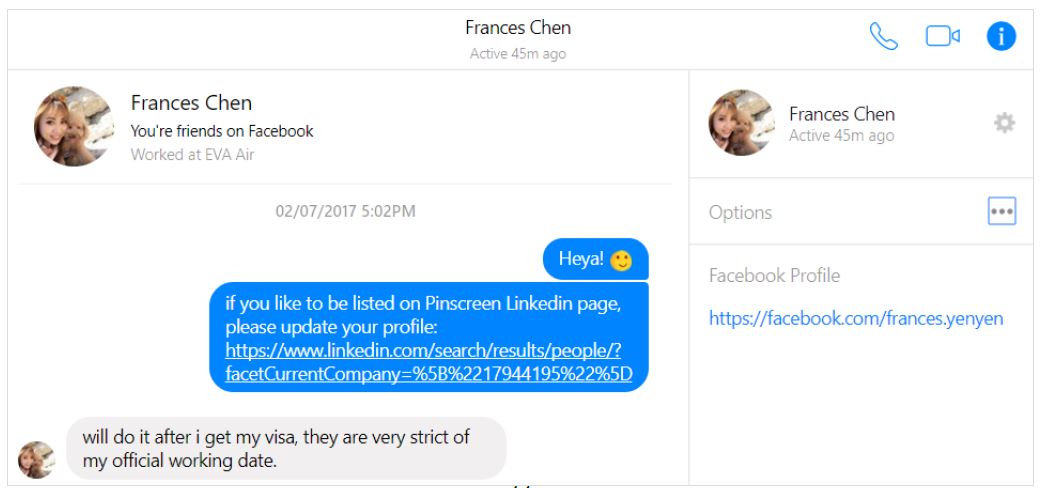
245. [February 3, 2017] Yen-Chun Chen: “Hi Iman,”
246. [February 3, 2017] Yen-Chun Chen: “I got your green card Pdf, We haven't received your confidential information signed one. [sic]”
247. [February 3, 2017] Yen-Chun Chen: “Can you send to us? [sic]”

248. On March 9, 2017, Sadeghi raised concerns about Pinscreen’s immigration law violations and requested that Li consult Pinscreen’s counsel to ensure Pinscreen’s compliance. In response, Li stated that he is “pretty sure that it's OK” and that he will “double check with the lawyers.”
249. On June 28, 2017, Sadeghi confronted Li about Pinscreen’s immigration law violations again. Sadeghi then followed up to inquire about the response from company's counsel. Li refused to give a response from Pinscreen’s counsel and told Sadeghi:
250. [June 28, 2017] Li: “You do not need to worry about these issues. Let me handle them.”
251. Since Li had promised to address Sadeghi’s concerns after Pinscreen’s SIGGRAPH 2017 RTL demo, Sadeghi requested, on Sunday, August 6, 2017, through e-mail to Li and Yen-Chun Chen, to set up a meeting with Li “to talk about multiple important topics.” Li agreed to have the meeting the next day, on Monday, August 7, 2017, at 5 p.m.:
[ Show Hidden Text ⇓ ]252. [August 6, 2017] Sadeghi: “I would like to have a 1:1 meeting to talk about multiple important topics. Are you free Monday or Tuesday night to talk over dinner?”
253. [August 6, 2017] Li: “Let’s meet at 5 p.m. in the office, we can discuss in the conference meeting room.”
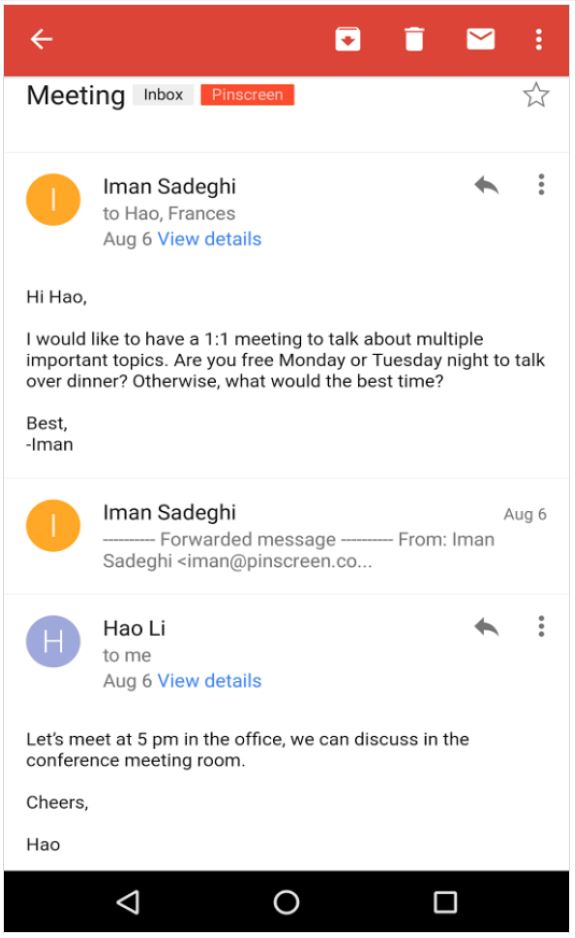
254. In Sadeghi’s meeting notes, titled “Pinscreen Concerns,” time-stamped by Google servers prior to the meeting, Sadeghi referenced Pinscreen’s data fabrication during the SIGGRAPH 2017 Real-Time Live demo and the SIGGRAPH Asia 2017 Technical Papers submission. Sadeghi stated that Pinscreen “can be accused of illegal crime.” Sadeghi’s notes included that “these decisions to promise things we don’t even have is coming from you [Li] and only you.”
255. Sadeghi’s meeting notes also contain a subsection regarding “overtime pay” with examples of Pinscreen employees who, on information and belief, had worked around 110 hours per week for three consecutive months, and did not receive overtime compensation from the company, in violation of California labor laws.
256. On August 7, 2017, Li suggested having the meeting immediately upon Sadeghi’s arrival to Pinscreen’s office, instead of at 5 p.m. as previously planned. Sadeghi met with Li and Yen-Chun Chen and reiterated his concerns about Li’s and Pinscreen’s data fabrication and past due overtime payments. Sadeghi stated his objections regarding Li refusing to properly compensate Pinscreen’s employees for overtime hours; Pinscreen “lying to thousands of people” during its RTL demo; Li putting “everyone’s academic reputation” at risk; and Li endangering Pinscreen’s investor relations due to the data fabrication. In response, moments before Li handed Sadeghi his termination letter from Pinscreen, Li told Sadeghi:
257. [August 7, 2017] Li: “Maybe I don’t want to further damage your reputation.”
258. [August 7, 2017] Li: “I don’t think you need to worry about these anymore.”
259. Sadeghi received the termination letter within his first working hour after Pinscreen’s fabricated RTL demo, which was during the meeting that Sadeghi had previously requested to discuss “multiple important topics” regarding Li’s and Pinscreen’s unlawful activities.
260. During the meeting, Sadeghi requested to meet Pinscreen’s full board of directors, including Kim, before the termination decision was final, to which Li responded, “sure.”
261. In response to Sadeghi’s inquiry for the reason of the termination, Li and Yen-Chun Chen stated:
262. [August 7, 2017] Sadeghi: “Tell me what are the reasons?”
263. [August 7, 2017] Li: “I don’t have to answer”
264. [August 7, 2017] Li: “I don’t have to tell you why”
265. [August 7, 2017] Li: “I think we are too small. We are not like Google.”
266. [August 7, 2017] Yen-Chun Chen: “The main reason is that we are too small for you.”
267. Sadeghi’s termination letter titled “Termination Information and Severance Agreement and General Release” stated that “the Company appreciates your service and is prepared to offer you severance in exchange for a release.” The letter did not mention any reason for the termination and was signed by Li and Yen-Chun Chen. (Exhibit H)
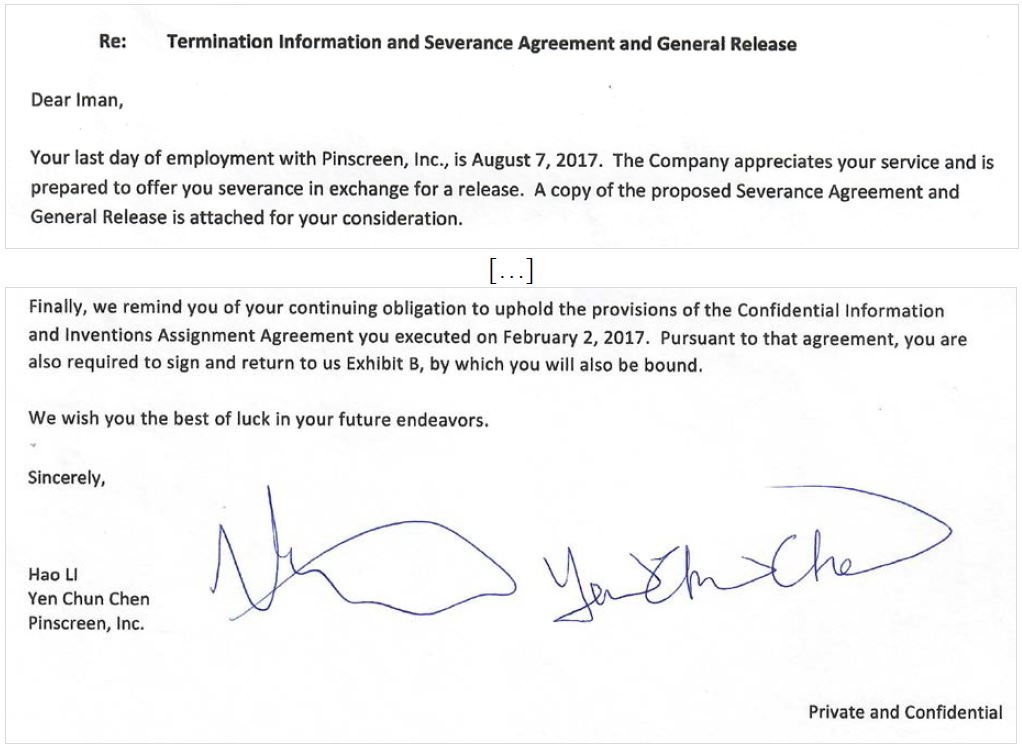
268. Pinscreen’s “Severance Agreement and General Release of Claims” letter offered Sadeghi one-month compensation in the amount of $13,750 in exchange for a release of claims and was signed by Li; Sadeghi did not sign Pinscreen’s severance offer. (Exhibit I)
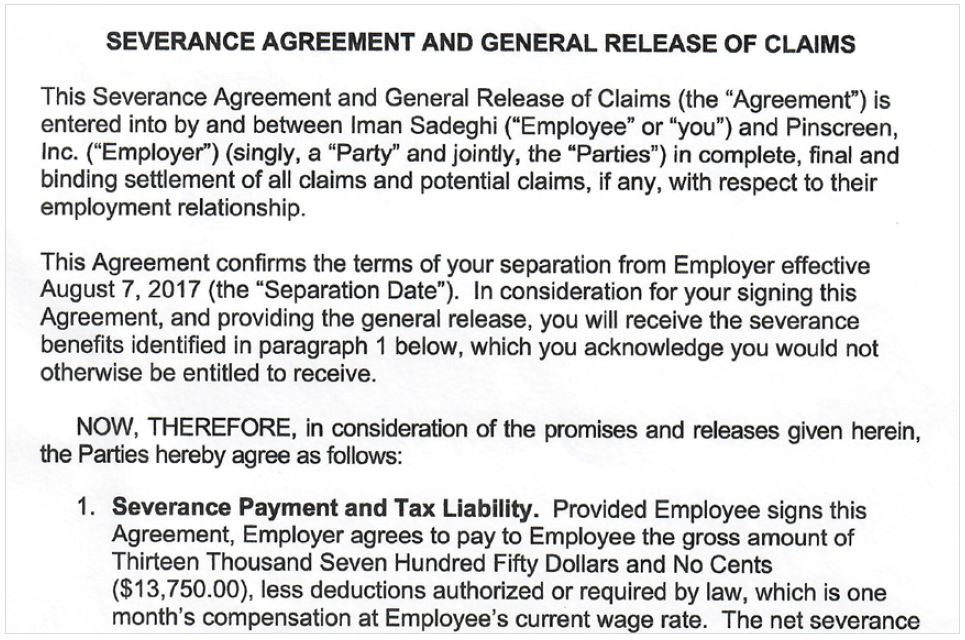
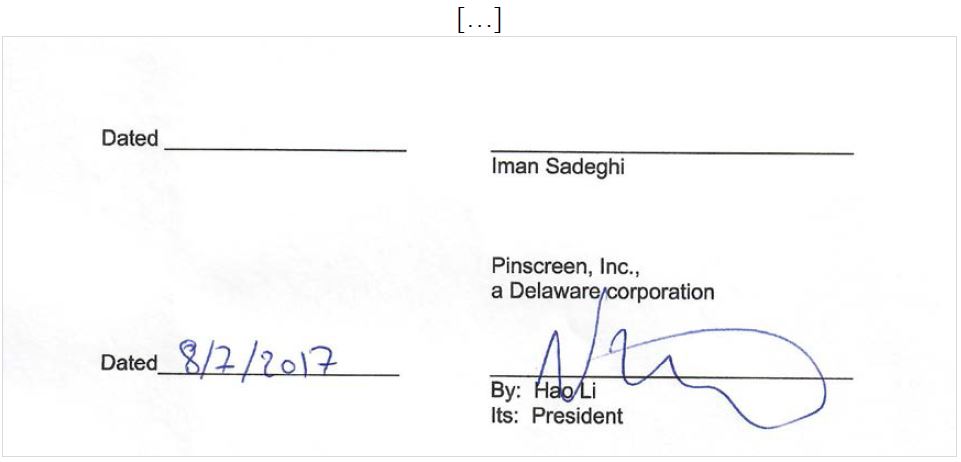
269. On August 9, 2017, two days after the termination, Sadeghi’s counsel requested Sadeghi’s “personnel file and all other records which Pinscreen maintains relating to Mr. Sadeghi’s employment, including without limitation, employee handbooks, policies, procedures, and investigative reports” pursuant to Labor Code § 1198.5, as well as “all documents Mr. Sadeghi signed that relate to his employment by Pinscreen” pursuant to California Labor Code § 432. Pinscreen’s response, dated September 8, 2018, contains no document whatsoever indicating any concerns with Sadeghi’s performance or employment. Pinscreen’s response contained no employee handbook, company policies, or codes of conduct. Sadeghi’s counsel also mentioned that Sadeghi “may have, among other things, a Labor Code § 1102.5 whistleblower retaliation claim and a claim for wrongful termination in violation of public policy” and demanded Pinscreen to “act immediately to preserve potentially relevant Electronically Stored Information (‘ESI’).”
270. There is no mention of any reason for Sadeghi’s termination in his employment personnel file, in his termination letter, or in his severance offer. There is no mention of any concern with Sadeghi’s performance or any other issue bearing on his qualities as an employee. Sadeghi received the termination letter “unexpectedly” as confirmed by Sadeghi’s statement in his Unemployment Insurance Claim application, filed on August 13, 2017. Employment Development Department (“EDD”) consequently approved Sadeghi’s application, on information and belief, after verifying the information provided by Sadeghi with Pinscreen.
271. [August 13, 2017] Sadeghi: “I received the termination and general release letter on Monday 8/7/2017 unexpectedly.”
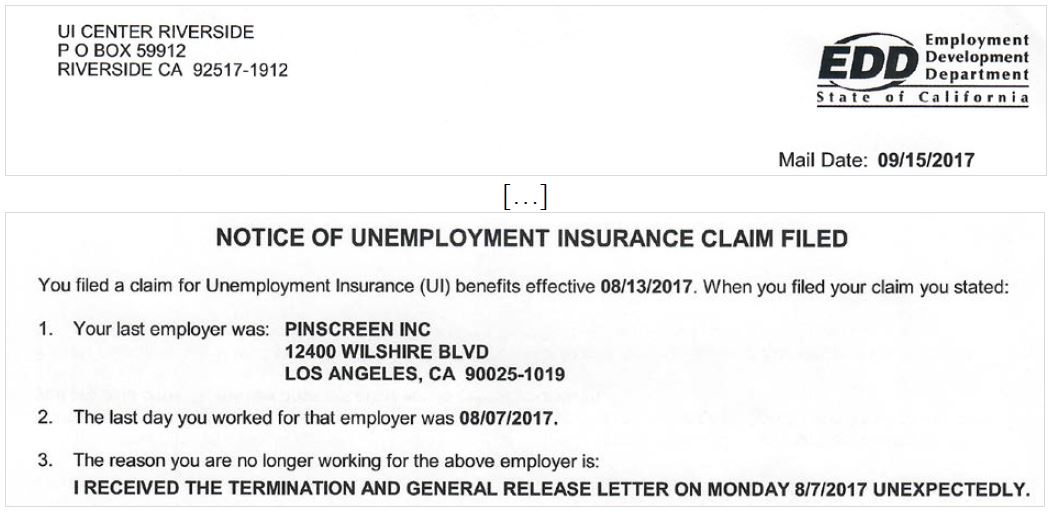
272. Sadeghi’s termination was in retaliation for his objections to Li regarding Li’s and Pinscreen’s illegal practices and in violation of California’s whistleblowing protection laws provided in California Labor Code § 1102.5.

273. Before Sadeghi had a chance to read the termination letter, Li suddenly lost his temper, slammed the conference room door open, and yelled at Sadeghi to leave the room, in front of Sadeghi’s coworkers and in a humiliating and embarrassing manner. Li then attempted to physically push Sadeghi out of the conference room in front of other Pinscreen employees.
274. [August 7, 2017] Sadeghi to Li: “You can’t touch me”
275. Concerned by Li’s aggressive behavior, Sadeghi decided to leave Pinscreen’s office; however, Li physically blocked the door of the office and forcefully confined Sadeghi against his will. Li demanded Sadeghi’s work laptop which was inside Sadeghi’s backpack that Sadeghi was wearing. Li then attempted to take the laptop by force.
276. [August 7, 2017] Sadeghi to Li: “You are being aggressive”
277. [August 7, 2017] Yen-Chun Chen to Li: “Let’s be calm. Let’s calm down. Calm down.”
278. Sadeghi intended to return the laptop before the end of business day, on August 7, 2017, and told Li that he would return it after he preserved his personal data. The storage of personal data complied with any applicable Pinscreen’s policies. In fact, Pinscreen had no policy regarding storing personal data on one’s computer, and no such policy was ever communicated to Sadeghi.
279. Subsequently, Sadeghi left Pinscreen’s office and headed towards the elevators. Li ordered some of Pinscreen’s employees to follow Sadeghi.
280. After Sadeghi, Li, and other employees left the elevator, Sadeghi attempted to leave the building through the lobby. However, Li and three other Pinscreen employees, Yen-Chun Chen, Hu, and Kung, under Li’s commands, surrounded Sadeghi and physically attacked him. They grabbed Sadeghi and his backpack, which he was wearing, forcefully restrained him, opened his backpack, and took possession of Sadeghi’s work laptop.
281. [August 7, 2017] Sadeghi to Li and the other defendants: “Don’t touch me. Don’t touch me.”
282. The battery, on information and belief, has been captured on the security cameras of the building and the recordings have been preserved by the building security team. The security officers on duty described the battery as Sadeghi being “grabbed,” “brought to the ground,” and “taken to the ground” by Pinscreen employees.
283. During the battery, Sadeghi suffered injuries to his eye and his previously dislocated shoulder, requiring medical attention and multiple physical therapy sessions.

284. Sadeghi has suffered severe mental and emotional distress as a result of the forced confinement, invasion of his privacy, battery and the consequent physical injuries; he required multiple psychotherapy sessions.
285. After Sadeghi’s termination, Pinscreen withheld business expense reimbursements including Sadeghi’s COBRA health insurance premiums despite prior written agreements. Pinscreen has subsequently acknowledged that reimbursements were owed but refused to pay them unless there was a successful settlement and/or Mutual Non-Disclosure Agreement (“MNDA”). After more than nine months delay, Pinscreen paid only a small portion of the past due reimbursements, in breach of Sadeghi’s contract, violation of prior written agreements, and in violation of California Labor Code § 2802. (Exhibits J3, J5)
286. Additionally, Pinscreen delayed paying Sadeghi his final wage payments, which according to California Labor Code § 203, entitled Sadeghi to waiting time penalties. On August 16, 2017, Pinscreen sent Sadeghi an undated letter with no signature, as well as a check for the late wage payment penalties in the amount of the waiting time penalties owed. Pinscreen phrased the purpose of the check as a settlement offer “to resolve any wage issues.” Sadeghi’s counsel requested Pinscreen, multiple times, including September 17, 2017, and December 29, 2017, to reissue another check for the waiting time penalties only and to exclude the settlement agreement verbiage. Pinscreen subsequently refused to do so and stated through Kim, on January 16, 2018, that reissuing a check would be “subject to execution of a mutually agreeable MNDA by and between Pinscreen and you [Sadeghi]” in violation of California Labor Code § 203. After more than nine months delay, on May 23, 2018, Pinscreen reissued another check without the settlement agreement verbiage. Sadeghi is entitled to his salary for 30 additional days. (Exhibits J2, J5)
287. The letter of Sadeghi’s counsel on August 9, 2017, 2 days after the termination, requested for Sadeghi’s personal property, pointing out that Sadeghi’s personal belongings are “valuable” and “fragile.” Nonetheless, Pinscreen damaged Sadeghi’s personal property remaining at Sadeghi’s desk at Pinscreen’s office. In storing it negligently, Pinscreen broke Sadeghi’s handmade sculpture, which has sentimental value. Sadeghi has demanded Pinscreen to reimburse him for the personal property damages. Subsequently, Pinscreen has refused to do so and stated through Kim, on January 16, 2018, that such reimbursement would be “subject to execution of a mutually agreeable MNDA” between Pinscreen and Sadeghi. (Exhibits J1, J5)
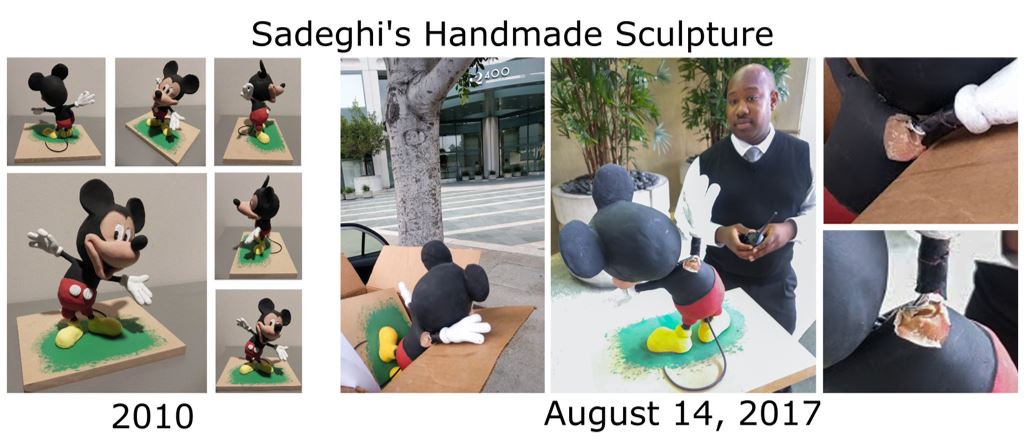
288. On January 16, 2018, Kim, a co-founder and a board member of Pinscreen, joined Sadeghi for a Google Hangout video conference call to talk about Sadeghi’s employment related claims. During the call, Sadeghi asked Kim whether he was aware of Li and Pinscreen’s data fabrication. Kim did not deny the fabrication in his response: (Exhibit J4)
289. [January 16, 2018] Sadeghi: “I don’t know if you knew about the data fabrication. Did you?”
290. [January 16, 2018] Kim: “Not in real time.”

291. After the video conference, on the same day, Kim send Sadeghi an e-mail with subject line “Re: Iman Sadeghi - Notice of Claim and Litigation Hold.” In his e-mail, Kim stated that Pinscreen would provide a check for the reimbursements, reissue a check to substitute for previous time penalty check, and provide a check for the personal property damage “subject to execution of mutually agreeable MNDA by and between Pinscreen and you.” (Exhibit J5)

292. Due to Li’s and Pinscreen’s violation of scientific research ethics and academic code of conduct, Sadeghi requested ACM and SIGGRAPH organizations to retract his name from Pinscreen’s fabricated publications. Li’s and Pinscreen’s fraud against the scientific community and academic misconduct were the proximate cause of Sadeghi having to sacrifice the scientific credit for his own significant contribution to these publications.
293. Sadeghi required multiple psychotherapy sessions as a result of the severe mental and emotional distress as a result of conversion of his personal data and infringement of his intellectual property rights.
294. Li was and is unfit and incompetent to perform the duties required for the CEO role at Pinscreen due to numerous instances of fraud, data fabrication, academic misconduct, disregard for California labor laws, disregard for federal immigration laws, and other illegal practices.
295. On information and belief, Li was and is ineligible to perform any role at Pinscreen due to his lack of proper work visa.
296. Li’s actions have been reckless, vicious, and have caused harm to Sadeghi, other Pinscreen employees, and Pinscreen’s investors and stakeholders.
297. Sadeghi was harmed and Pinscreen is liable because Pinscreen negligently hired and retained an unfit, incompetent, and ineligible CEO, did not properly train him, did not properly supervise him, and did not properly verify his eligibility.
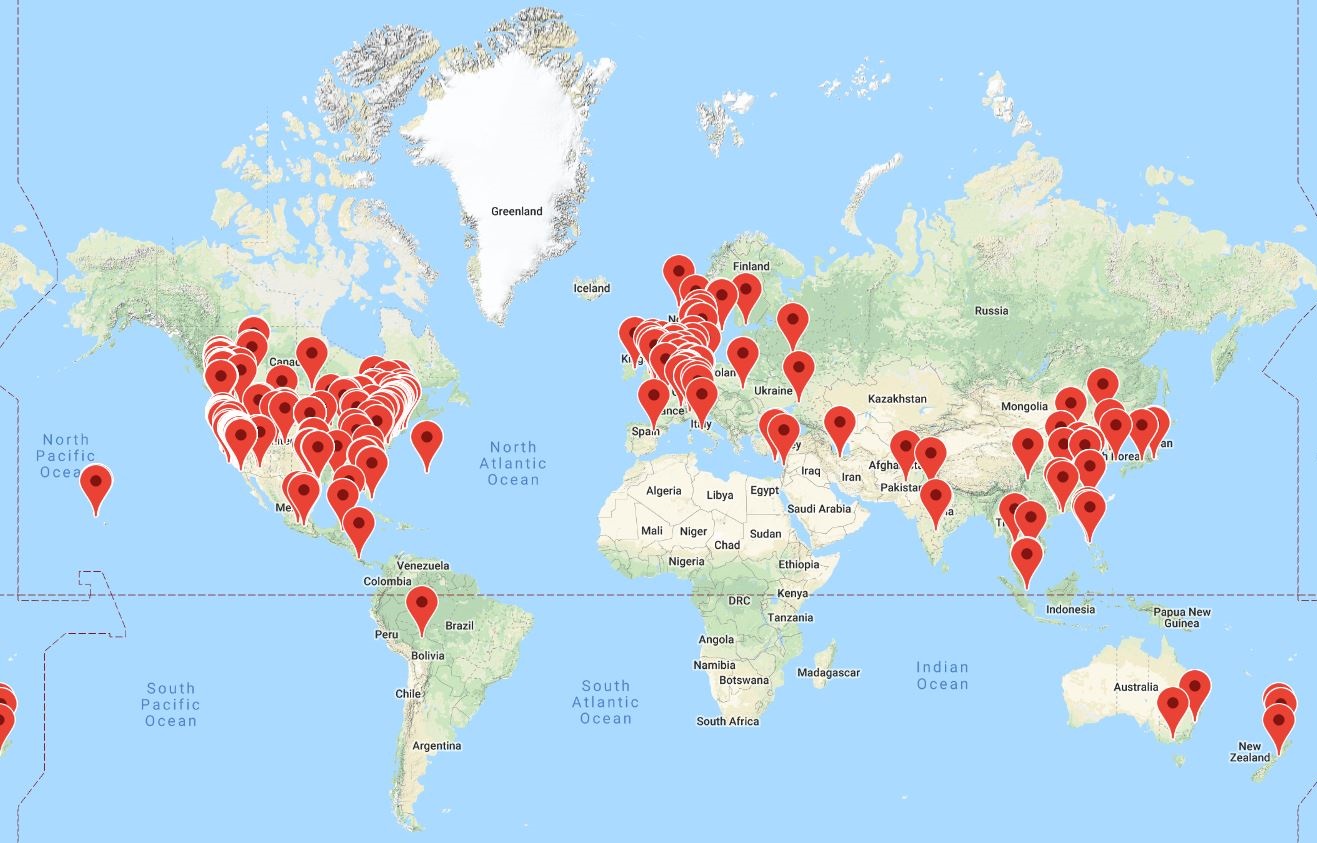
Dr. Iman Sadeghi v. Pinscreen Inc., et al.Superior Court of the State of California, County of Los Angeles, Central District., Filed June 11, 2018.
@article{Dr-Iman-Sadeghi-v-Pinscreen-Inc-et-al,
title = {Dr. Iman Sadeghi v. Pinscreen Inc., et al.},
publisher = {Superior Court of the State of California, County of Los Angeles, Central District.},
month = {June},
day = {11},
year = {2018},
}